After months of silence, Voyager 1 has returned NASA’s calls

- Show more sharing options
- Copy Link URL Copied!
For the last five months, it seemed very possible that a 46-year-old conversation had finally reached its end.
Since its launch from Kennedy Space Center on Sept. 5, 1977, NASA’s Voyager 1 spacecraft has diligently sent regular updates to Earth on the health of its systems and data collected from its onboard instruments.
But in November, the craft went quiet.
Voyager 1 is now some 15 billion miles away from Earth. Somewhere in the cold interstellar space between our sun and the closest stars, its flight data system stopped communicating with the part of the probe that allows it to send signals back to Earth. Engineers at the Jet Propulsion Laboratory in La Cañada Flintridge could tell that Voyager 1 was getting its messages, but nothing was coming back.
“We’re to the point where the hardware is starting to age,” said Linda Spilker, the project scientist for the Voyager mission. “It’s like working on an antique car, from 15 billion miles away.”
Week after week, engineers sent troubleshooting commands to the spacecraft, each time patiently waiting the 45 hours it takes to get a response here on Earth — 22.5 hours traveling at the speed of light to reach the probe, and 22.5 hours back.

Science & Medicine

This space artist created the Golden Record and changed the way we see the universe
Space artist Jon Lomberg has produced work that attempts to visualize what we can’t truly see, and to communicate with creatures we can’t yet imagine.
July 26, 2023
By March, the team had figured out that a memory chip that stored some of the flight data system’s software code had failed, turning the craft’s outgoing communications into gibberish.
A long-distance repair wasn’t possible. There wasn’t enough space anywhere in the system to shift the code in its entirety. So after manually reviewing the code line by line, engineers broke it up and tucked the pieces into the available slots of memory.
They sent a command to Voyager on Thursday. In the early morning hours Saturday, the team gathered around a conference table at JPL: laptops open, coffee and boxes of doughnuts in reach.
At 6:41 a.m., data from the craft showed up on their screens. The fix had worked .
“We went from very quiet and just waiting patiently to cheers and high-fives and big smiles and sighs of relief,” Spilker said. “I’m very happy to once again have a meaningful conversation with Voyager 1.”
Voyager 1 is one of two identical space probes. Voyager 2, launched two weeks before Voyager 1, is now about 13 billion miles from Earth, the two crafts’ trajectories having diverged somewhere around Saturn. (Voyager 2 continued its weekly communications uninterrupted during Voyager 1’s outage.)

Space shuttle Endeavour is lifted into the sky, takes final position as star of new museum wing
A shrink-wrapped Endeavour was hoisted and then carefully placed in its final location Tuesday at the still-under-construction Samuel Oschin Air and Space Center.
Jan. 30, 2024
They are the farthest-flung human-made objects in the universe, having traveled farther from their home planet than anything else this species has built. The task of keeping communications going grows harder with each passing day. Every 24 hours, Voyager 1 travels 912,000 miles farther away from us. As that distance grows, the signal becomes slower and weaker.
When the probe visited Jupiter in 1979, it was sending back data at a rate of 115.2 kilobits per second, Spilker said. Today, 45 years and more than 14 billion miles later, data come back at a rate of 40 bits per second.
The team is cautiously optimistic that the probes will stay in contact for three more years, long enough to celebrate the mission’s 50th anniversary in 2027, Spilker said. They could conceivably last until the 2030s.
The conversation can’t last forever. Microscopic bits of silica keep clogging up the thrusters that keep the probes’ antennas pointed toward Earth, which could end communications. The power is running low. Eventually, the day will come when both Voyagers stop transmitting data to Earth, and the first part of their mission ends.
But on the day each craft goes quiet, they begin a new era, one that could potentially last far longer. Each probe is equipped with a metallic album cover containing a Golden Record , a gold-plated copper disk inscribed with sounds and images meant to describe the species that built the Voyagers and the planet they came from.
Erosion in space is negligible; the images could be readable for another billion years or more. Should any other intelligent life form encounter one of the Voyager probes and have a means of retrieving the data from the record, they will at the very least have a chance to figure out who sent them — even if our species is by that time long gone.
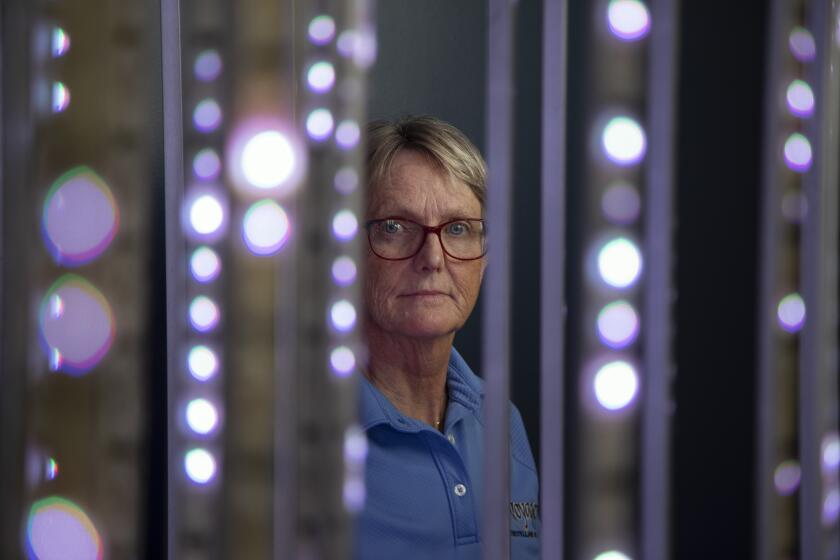
JPL tries to keep Voyager space probes from disconnecting the world’s longest phone call
Keeping in touch with NASA’s two aging Voyager spacecraft is getting harder to do as they get farther away and their power sources dwindle.
Sept. 3, 2022
More to Read

Too expensive, too slow: NASA asks for help with JPL’s Mars Sample Return mission
April 15, 2024

NASA’s attempt to bring home part of Mars is unprecedented. The mission’s problems are not
March 25, 2024
Budget deal for NASA offers glimmer of hope for JPL’s Mars Sample Return mission
March 6, 2024

Corinne Purtill is a science and medicine reporter for the Los Angeles Times. Her writing on science and human behavior has appeared in the New Yorker, the New York Times, Time Magazine, the BBC, Quartz and elsewhere. Before joining The Times, she worked as the senior London correspondent for GlobalPost (now PRI) and as a reporter and assignment editor at the Cambodia Daily in Phnom Penh. She is a native of Southern California and a graduate of Stanford University.
More From the Los Angeles Times

Commencement speakers launch boycott of USC satellite graduation ceremonies

Post Malone’s all-star Stagecoach set includes Brad Paisley, Dwight Yoakam
April 27, 2024

L.A. supervisors oppose plan to eradicate Catalina deer by shooting them from helicopters

Southern California woman pleads guilty in $150-million counterfeit postage scheme
Voyager 1 talking to Earth again after NASA engineers 24 billion kilometres away devise software fix
NASA's Voyager 1 probe — the most distant man-made object in the universe — is returning usable information to ground control following months of spouting gibberish, the US space agency says.
The spaceship stopped sending readable data back to Earth on November 14, 2023, even though controllers could tell it was still receiving their commands.
In March, teams working at NASA's Jet Propulsion Laboratory discovered that a single malfunctioning chip was to blame.
They then had to devise a clever coding fix that worked within the tight memory constraints of its 46-year-old computer system.
"There was a section of the computer memory no longer working," project leader Dr Linda Spilker told the ABC.
"So we had to reprogram what was in that memory, move it to a different location, link everything back together and send everything up in a patch.
"And then on Saturday morning, we watched as Voyager 1 sent its first commands back and we knew we were back in communication once again."
Dr Spilker said they were receiving engineering data, so they knew the health and safety of the spacecraft.
"The next step is going to be to develop a patch so we can send back the science data," she said.
"That will really be exciting, to once again learn about interstellar space and what has been going on there that we've missed since November."
Dr Spilker said Voyager sent back data in real time, so the team had no facility to retrieve data covering the time since transmission was lost.
Launched in 1977, Voyager 1 was mankind's first spacecraft to enter the interstellar medium , in 2012, and is currently more than 24 billion kilometres from Earth.
Messages sent from Earth take about 22.5 hours to reach the spacecraft.
Its twin, Voyager 2, also left the solar system in 2018 as it was tracked by Australia's Parkes radio telescope.
Australia was also vital to a 2023 search for Voyager 2 after signals were lost, with Canberra's Deep Space Communication Complex monitoring for signals and then sending a successful command to shift the spacecraft's antenna 2 degrees .
Both Voyager spacecraft carry " Golden Records ": 12-inch, gold-plated copper disks intended to convey the story of our world to extraterrestrials.
These include a map of our solar system, a piece of uranium that serves as a radioactive clock allowing recipients to date the spaceship's launch, and symbolic instructions that convey how to play the record.
The contents of the record, selected for NASA by a committee chaired by legendary astronomer Carl Sagan, include encoded images of life on Earth, as well as music and sounds that can be played using an included stylus.
Their power banks were expected to be depleted sometime after 2025, but Dr Spilker said several systems had been turned off, so they were hopeful the two spacecraft would function into the 2030s.
They will then continue to wander the Milky Way, potentially for eternity, in silence.
- X (formerly Twitter)
Related Stories
Nasa restores contact with missing voyager 2 spacecraft after weeks of silence.
How songs from tiny villages in the Pacific are now floating in outer space
Voyager 1 spacecraft enters interstellar space
- Astronomy (Space)
- Computer Science
- Space Exploration
- United States
Subscribe or renew today
Every print subscription comes with full digital access
Science News
‘humanity’s spacecraft’ voyager 1 is back online and still exploring.
After five months of glitching, the spacecraft is talking to Earth again from interstellar space

The Voyager 1 spacecraft (illustrated) is back online after a few months of transmitting garbled data. It’s now poised to continue its exploration of interstellar space.
JPL-Caltech/NASA
Share this:
By Ramin Skibba
April 26, 2024 at 11:45 am
After months of challenging trouble-shooting and suspenseful waiting, Voyager 1 is once again talking to Earth.
The aging NASA spacecraft, about 24 billion kilometers from home, began transmitting garbled data in November. On April 20, NASA scientists got the probe back online after uploading new flight software to work around a chunk of onboard computer memory that had failed. They’re now receiving data about the spacecraft’s health and hope to hear from its science instruments again in a few weeks, says Suzanne Dodd, the mission’s project manager at NASA’s Jet Propulsion Laboratory in Pasadena, Calif.
That means the iconic craft could be on a path to recovery — and to continue its exploration of interstellar space.
Launched in 1977, Voyager 1 briefly visited Jupiter and Saturn before eventually departing the solar system. It and its twin, Voyager 2, are the longest-operating space probes, now tasked with studying far-flung solar particles and cosmic rays. In particular, the probes have been monitoring the changing of the sun’s magnetic field and the density of plasma beyond the solar system, yielding information about the farthest reaches of the sun’s influence .
“The spacecraft is really remarkable in its longevity. It’s incredible,” Dodd says. “We want to keep Voyager going as long as possible so we have this time record of these changes.”
Voyager 1 and 2, cruising along diverging paths, made history by crossing the heliopause in 2012 and 2018 , respectively ( SN: 9/12/13; SN: 12/10/18 ). At nearly 18 billion kilometers from the sun, that’s long been considered the outer extent of our star’s magnetic field and the solar wind, the boundary before interstellar space.
Since then, Dodd says, the science team has made some surprising findings ( SN: 11/4/19 ). For one, they’ve determined that the heliosphere, the huge bubble of space dominated by the solar wind, might not be spherical but have one or two tails, making it shaped like a comet or a croissant.
And thanks to Voyager, scientists now know that, despite expectations otherwise, the sun’s magnetic field and charged particles actually remain significant even beyond the heliopause, says David McComas, a Princeton University astrophysicist not involved in the mission.
Some theories predicted a serene environment in the distant oceans of interstellar space, but the Voyagers keep passing through waves of charged particles, indicating that the solar magnetic field still holds some sway there. What’s more, the probes’ data have shown how ripples in the field form bubbles at the edge of the solar system, which is more frothy and dynamic than expected.
Other missions have begun building on Voyager’s solar physics research. These include NASA’s Interstellar Boundary Explorer, or IBEX, and the Interstellar Mapping and Acceleration Probe, or IMAP, which is set to launch next year. Earth-orbiting IBEX has been measuring high-energy particles to map the heliosphere for 15 years, whereas IMAP will orbit between the sun and Earth, giving it an uninterrupted view of the sun as it monitors the galactic cosmic rays that manage to filter through the heliosphere.
“There’s a huge synergy between the Voyagers and both IBEX and IMAP,” says McComas, principal investigator of the latter two missions. “We were all really scared when Voyager 1 stopped phoning home.”
It will be decades until another mission could accomplish what the Voyagers have done. NASA’s New Horizons soared by Pluto in 2015 and kept going ( SN:8/9/18 ). It’s heading toward the edge of the solar system, but it’s cruising slowly and will run out of power before it can collect data beyond the heliopause.
The Voyagers can fly forever, but power for their instruments is waning. Over the next few years, NASA will shut some down to conserve energy for the rest.
That means Voyager 1’s days of collecting science data are numbered. “It’s a very beloved mission,” Dodd says. “It’s humanity’s spacecraft, and we need to take care of it.”
More Stories from Science News on Space

Separating science fact from fiction in Netflix’s ‘3 Body Problem’

Pluto’s heart-shaped basin might not hide an ocean after all

Our picture of habitability on Europa, a top contender for hosting life, is changing

Jupiter’s moon Io may have been volcanically active ever since it was born

50 years ago, scientists found a lunar rock nearly as old as the moon

How a sugar acid crucial for life could have formed in interstellar clouds

What Science News saw during the solar eclipse

During the awe of totality, scientists studied our planet’s reactions
Subscribers, enter your e-mail address for full access to the Science News archives and digital editions.
Not a subscriber? Become one now .
- Skip to main content
- Keyboard shortcuts for audio player
Good news from Voyager 1, which is now out past the edge of the solar system

Nell Greenfieldboyce
In mid-November, Voyager 1 suffered a glitch, and it's messages stopped making sense. But the NASA probe is once again sending messages to Earth that make sense.
JUANA SUMMERS, HOST:
We recently shared news of some troubles being experienced by the Voyager 1 spacecraft. The historic NASA probe launched in 1977 to explore Jupiter and Saturn. Then it just kept going. It's now out beyond the edge of the solar system in the previously unexplored space between stars. And it still regularly talks to Earth. But in mid-November, it suffered a glitch, and its messages, well, they stopped making sense. NPR's Nell Greenfieldboyce now has this update from the Voyager team with some good news.
NELL GREENFIELDBOYCE, BYLINE: A small dedicated team at NASA's Jet Propulsion Laboratory has spent the last five months trying to figure out how to help Voyager 1, which wasn't easy because everything the poor spacecraft sent back was just incoherent.
LINDA SPILKER: That's what took the time and effort, figuring out exactly what was the problem.
GREENFIELDBOYCE: Linda Spilker is the Voyager mission's project scientist. She says they finally traced the glitch to a failed memory chip in one of the spacecraft's primitive computers.
SPILKER: And so that meant we had to move all of those pieces of code to a different place in the memory, and that's what we did.
GREENFIELDBOYCE: But it was tricky. After all, the spacecraft is over 15 billion miles away. And its computers are so ancient that the team had no way to test that their fix would really work. Still, mission managers sent out the carefully crafted computer commands. Then they waited to receive Voyager 1's response. Spilker says everyone gathered together in a conference room early Saturday morning, nervously munching on peanuts.
SPILKER: In those couple of minutes, just before that signal was coming back - 6:41 A.M. - you could have heard a pin drop in that room.
GREENFIELDBOYCE: When the signal arrived, everything looked good, normal.
SPILKER: Everyone just broke out in cheers and smiles, and it was just a huge celebration. We were in such relief, as well. Voyager 1 was back.
GREENFIELDBOYCE: Voyager 1's first messages contained information on the health and safety of its engineering systems, plus its precious antenna.
SPILKER: It looks like the spacecraft is in good shape, much like we left it back in mid-November.
GREENFIELDBOYCE: Spilker says the plan now is to find some more free memory on a working chip and put in the software that will let Voyager 1 resume transmission of its science data, so that researchers will be able to follow along as the spacecraft travels through an interstellar stew of gas, dust and cosmic rays. And the team ultimately hopes to sustain Voyager 1 and its twin Voyager 2 for at least a few more years so that the Voyager mission will still be doing science on the 50th anniversary of its launch.
Nell Greenfieldboyce, NPR News.
(SOUNDBITE OF ALEXANDER COURAGE AND GENE RODDENBERRY'S "THEME FROM 'STAR TREK'")
Copyright © 2024 NPR. All rights reserved. Visit our website terms of use and permissions pages at www.npr.org for further information.
NPR transcripts are created on a rush deadline by an NPR contractor. This text may not be in its final form and may be updated or revised in the future. Accuracy and availability may vary. The authoritative record of NPR’s programming is the audio record.

NASA re-establishes communication with Voyager 1 interstellar spacecraft that went silent for months
NASA and Voyager 1 are communicating back and forth again, after the most distant human-made object in space stopped sending usable data back to the space agency nearly five months ago.
NASA’s Jet Propulsion Laboratory said Voyager 1, which is more than 15 billion miles away from Earth, stopped sending readable data back to scientists on Nov. 14, 2023, though mission controllers could still see the spacecraft was receiving commands and operating as intended.
The Southern California-based engineering team responsible for Voyager 1 investigated the problem and learned the issue was connected to one of the spacecraft’s three onboard computers, which is called the Flight Data Subsystem (FDS).
The FDS packages the data collected by the spacecraft before sending it back to earth.
RARE STAR EXPLOSION EXPECTED TO BE ‘ONCE-IN-A-LIFETIME VIEWING OPPORTUNITY,’ NASA OFFICIALS SAY
Engineers discovered the chip responsible for storing a portion of the FDS memory was faulty, making the code unusable.
READ ON THE FOX NEWS APP
Had the spacecraft been located on Earth, engineers would be able to go in and replace a chip, but because it is in interstellar space, engineers needed to figure out a way to move the affected code somewhere else in the FDS memory.
The code is so large that there is not a single location to store the entire section of the code. So, engineers divided the affected code into sections and planned to move them to various locations in the FDS.
NASA PUBLISHES NEVER-BEFORE-SEEN PHOTOS OF ‘RAVIOLI’ MOON ORBITING SATURN
Engineers also had to make sure the code worked together as a whole after being moved.
Once the code was reconfigured, engineers transmitted the changes to the FDS memory on April 18.
The signal takes about 22.5 hours to travel through space until it reaches Voyager 1, and then another 22.5 hours for a signal to come back to earth.
VOYAGER 1 DETECTS ‘HUM’ WHILE IN INTERSTELLAR SPACE: REPORT
On April 20, the mission team received a response from Voyager 1 and confirmed the modification worked. As a result, engineers now have the ability to check the health and status of the spacecraft.
In the coming months, the team plans to move and adjust additional portions of the FDS software that was affected, including portions that send scientific data back to mission control.
Voyager 1′s odyssey began in 1977 when the spacecraft and its twin, Voyager 2, were launched on a tour of the gas giant planets of the solar system.
After beaming back dazzling postcard views of Jupiter’s giant red spot and Saturn’s shimmering rings, Voyager 2 hopscotched to Uranus and Neptune . Meanwhile, Voyager 1 used Saturn as a gravitational slingshot to power itself past Pluto.
Original article source: NASA re-establishes communication with Voyager 1 interstellar spacecraft that went silent for months
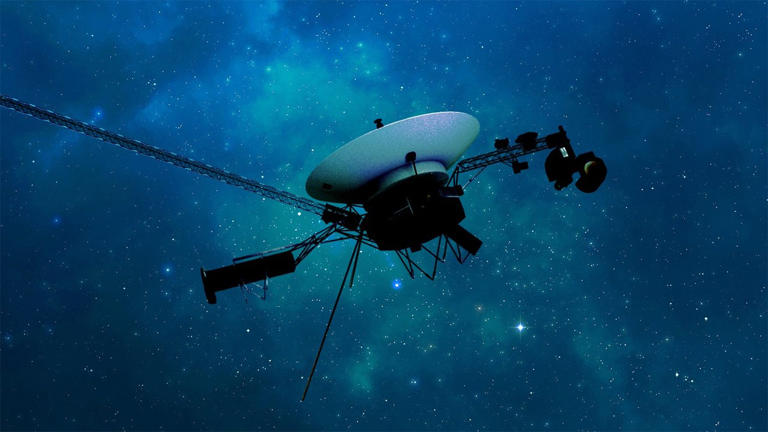
NASA Hears From Voyager 1, the Most Distant Spacecraft From Earth, After Months of Quiet
NASA has finally heard back from Voyager 1 in a way that makes sense

This illustration provided by NASA depicts Voyager 1. The most distant spacecraft from Earth stopped sending back understandable data in November 2023. Flight controllers traced the blank communication to a bad computer chip and rearranged the spacecraft’s coding to work around the trouble. In mid-April 2024, NASA’s Jet Propulsion Laboratory declared success after receiving good engineering updates. The team is still working to restore transmission of the science data. (NASA via AP)
CAPE CANAVERAL, Fla. (AP) — NASA has finally heard back from Voyager 1 again in a way that makes sense.
The most distant spacecraft from Earth stopped sending back understandable data last November. Flight controllers traced the blank communication to a bad computer chip and rearranged the spacecraft’s coding to work around the trouble.
NASA’s Jet Propulsion Laboratory in Southern California declared success after receiving good engineering updates late last week. The team is still working to restore transmission of the science data.
It takes 22 1/2 hours to send a signal to Voyager 1, more than 15 billion miles (24 billion kilometers) away in interstellar space. The signal travel time is double that for a round trip.
Contact was never lost, rather it was like making a phone call where you can’t hear the person on the other end, a JPL spokeswoman said Tuesday.
Launched in 1977 to study Jupiter and Saturn, Voyager 1 has been exploring interstellar space — the space between star systems — since 2012. Its twin, Voyager 2, is 12.6 billion miles (20 billion kilometers) away and still working fine.
Photos You Should See - April 2024

The Associated Press Health and Science Department receives support from the Howard Hughes Medical Institute’s Science and Educational Media Group. The AP is solely responsible for all content.
Copyright 2024 The Associated Press . All rights reserved. This material may not be published, broadcast, rewritten or redistributed.
Join the Conversation
Tags: Associated Press , science
America 2024

Health News Bulletin
Stay informed on the latest news on health and COVID-19 from the editors at U.S. News & World Report.
Sign in to manage your newsletters »
Sign up to receive the latest updates from U.S News & World Report and our trusted partners and sponsors. By clicking submit, you are agreeing to our Terms and Conditions & Privacy Policy .
You May Also Like
The 10 worst presidents.
U.S. News Staff Feb. 23, 2024

Cartoons on President Donald Trump
Feb. 1, 2017, at 1:24 p.m.

Photos: Obama Behind the Scenes
April 8, 2022

Photos: Who Supports Joe Biden?
March 11, 2020

RFK Jr.: By the Numbers
Laura Mannweiler April 26, 2024

Biden’s Student Loan Chief to Step Down
Lauren Camera April 26, 2024

What to Know: Bird Flu Virus in Milk
Cecelia Smith-Schoenwalder April 26, 2024

Inflation a Stubborn Foe for the Fed
Tim Smart April 26, 2024

The Curse of the Modern Vice President

‘A Rule for the Ages’
Lauren Camera April 25, 2024

The remarkable twin Voyager spacecraft continue to explore the outer reaches of the solar system decades after they completed their surveys of the Outer Planets. Launched in 1977 (September 5 for Voyager 1 (V1) and August 20 for Voyager 2 (V2), whose trajectory took it past Jupiter after Voyager 1), the spacecraft pair made many fundamental discoveries as they flew past Jupiter (March 1979 for V1, July 1979 for V2) and Saturn (November 1980 for V1, August 1981 for V2). The path of Voyager 2 past Saturn was targeted so that it continued within the plane of the solar system, allowing it to become the first spacecraft to visit Uranus (January 1986) and Neptune (August 1989). Following the Neptune encounter, both spacecraft started a new phase of exploration under the intriguing title of the Voyager Interstellar Mission.
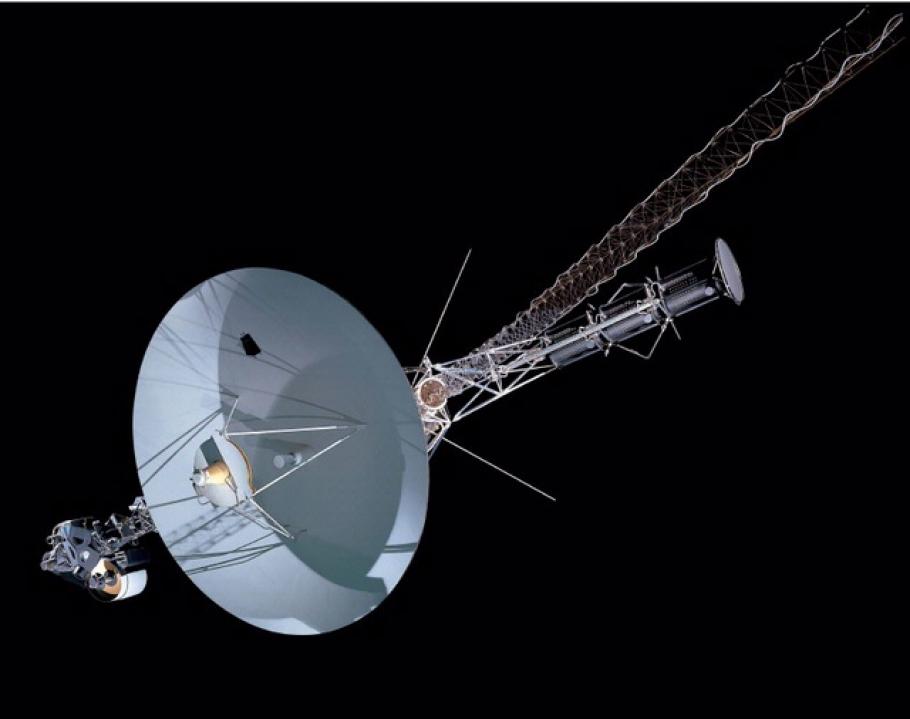
Five instruments continue to collect important measurements of magnetic fields, plasmas, and charged particles as both spacecraft explore different portions of the solar system beyond the orbits of the planets. Voyager 1 is now more than 118 astronomical units (one AU is equal to the average orbital distance of Earth from the Sun) distant from the sun, traveling at a speed (relative to the sun) of 17.1 kilometers per second (10.6 miles per second). Voyager 2 is now more than 96 AU from the sun, traveling at a speed of 15.5 kilometers per second (9.6 miles per second). Both spacecraft are moving considerably faster than Pioneers 10 and 11, two earlier spacecraft that became the first robotic visitors to fly past Jupiter and Saturn in the mid-70s.
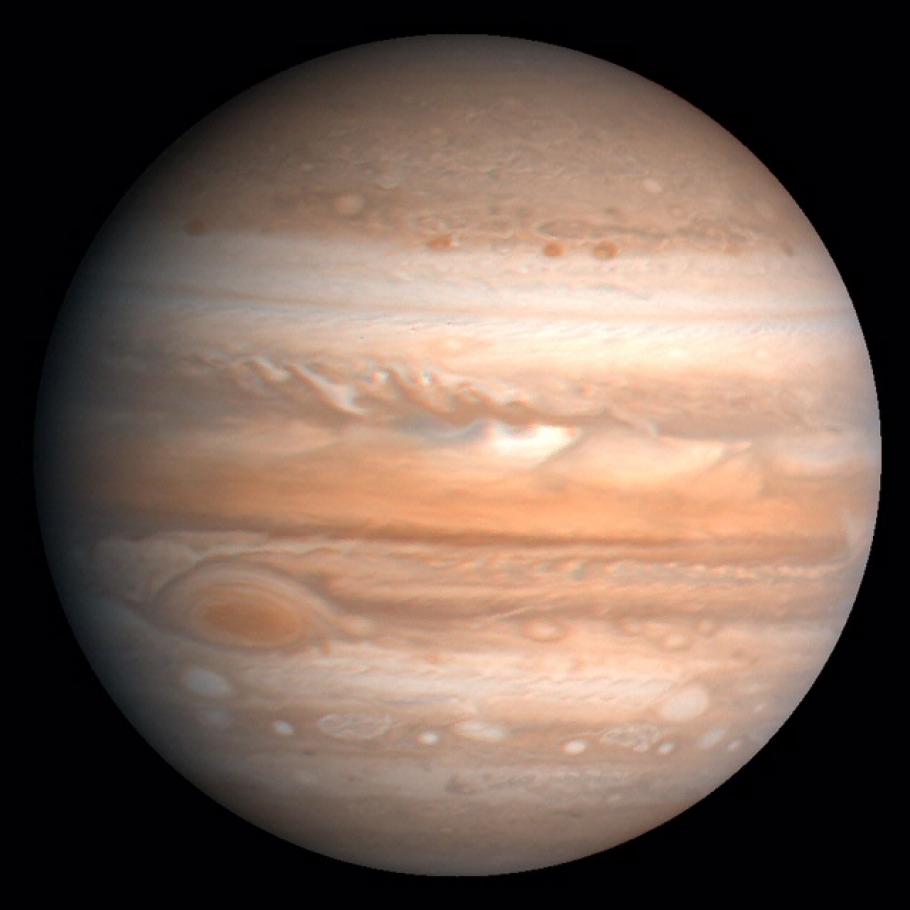
This processed color image of Jupiter was produced in 1990 by the U.S. Geological Survey from a Voyager image captured in 1979. The colors have been enhanced to bring out detail. Zones of light-colored, ascending clouds alternate with bands of dark, descending clouds. The clouds travel around the planet in alternating eastward and westward belts at speeds of up to 540 kilometers per hour. Tremendous storms as big as Earthly continents surge around the planet. The Great Red Spot (oval shape toward the lower-left) is an enormous anticyclonic storm that drifts along its belt, eventually circling the entire planet.
As seen in the night sky at Earth, Voyager 1 is within the confines of the constellation Ophiuchus, only slightly above the celestial equator; no telescope can see it, but radio contact is expected to be maintained for at least the next ten years. Voyager 2 is within the bounds of the constellation Telescopium (which somehow sounds quite appropriate) in the far southern night sky.
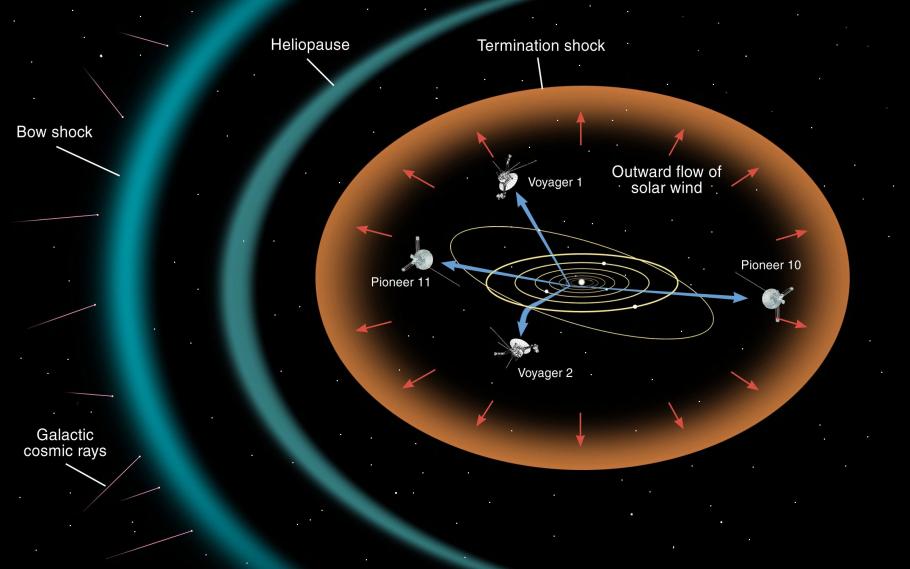
Both spacecraft have already passed something called the Termination Shock † (December 2004 for V1, August 2007 for V2), where the solar wind slows as it starts to interact with the particles and fields present between the stars. It is expected that both spacecraft will encounter the Heliopause, where the solar wind ceases as true interstellar space begins, from 10 to 20 years after crossing the Termination Shock. Theories exist for what should be present in interstellar space, but the Voyagers will become the first man-made objects to go beyond the influences of the Sun, hopefully returning the first measurements of what it is like out there. Each spacecraft is carrying a metal record with encoded sounds and sights from Earth, along with the needle needed to read the recordings, and simplified instructions for where the spacecraft came from, in case they are eventually discovered by intelligent extra-terrestrials.
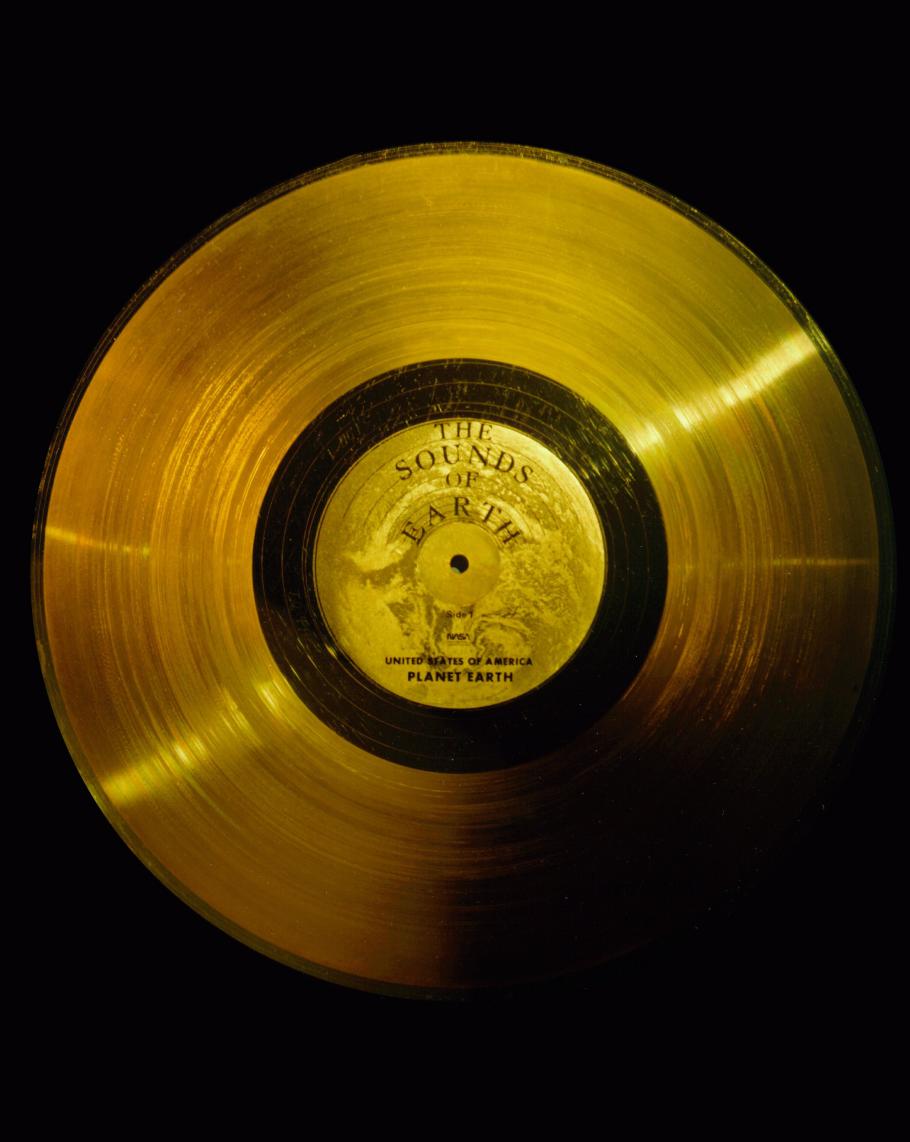
Keep track of the Voyager spacecraft on the official Voyager Interstellar Mission website or follow @NASAVoyager2 on Twitter. † The sun ejects a continuous stream of charged particles (electrons, protons, etc) that is collectively termed the solar wind. The particles are traveling extremely fast and are dense enough to form a very tenuous atmosphere; the heliosphere represents the volume of space where the effects of the solar wind dominate over those of particles in interstellar space. The solar wind particles are moving very much faster than the local speed of sound represented by their low volume density. When the particles begin to interact with interstellar particles and fields (the interaction can be either physically running into other particles or experiencing an electromagnetic force resulting from a charged particle moving within a magnetic field), then they start to slow down. The point at which they become subsonic (rather than their normal hypersonic speed) is the Termination Shock.
We rely on the generous support of donors, sponsors, members, and other benefactors to share the history and impact of aviation and spaceflight, educate the public, and inspire future generations. With your help, we can continue to preserve and safeguard the world’s most comprehensive collection of artifacts representing the great achievements of flight and space exploration.
- Get Involved
- Host an Event
Thank you. You have successfully signed up for our newsletter.
Error message, sorry, there was a problem. please ensure your details are valid and try again..
- Free Timed-Entry Passes Required
- Terms of Use
Advertisement
NASA makes sense of Voyager 1's garbled signals from the edge of the solar system
Copy the code below to embed the wbur audio player on your site.
<iframe width="100%" height="124" scrolling="no" frameborder="no" src="https://player.wbur.org/hereandnow/2024/04/24/voyager-1-nasa-solar-system"></iframe>
- Nell Greenfieldboyce, NPR
Voyager 1 was originally launched in the 1970s, and the space probe is now sailing outside our solar system. A computer glitch scrambled its communications with Earth, leaving NASA in the dark.
Now, scientists have restored Voyager 1 and are making sense of its signals from interstellar space.
NPR science correspondent Nell Greenfieldboyce reports.
This segment aired on April 24, 2024.
More from Here & Now
The most distant spacecraft in the solar system — Where are they now?
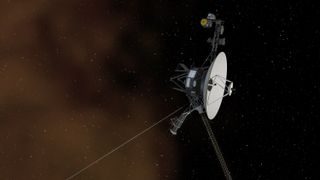
Humans have been flinging things into deep space for 50 years now, since the 1972 launch of Pioneer 10. We now have five spacecraft that have either reached the edges of our solar system or are fast approaching it: Pioneer 10, Pioneer 11, Voyager 1, Voyager 2 and New Horizons.
Most of these probes have defied their expected deaths and are still operating long beyond their original mission plans. These spacecraft were originally planned to explore our neighboring planets, but now they're blazing a trail out of the solar system , providing astronomers with unique vantage points in space — and they've been up to a lot in 2022.
Voyagers 1 and 2
The Voyager missions celebrated a very special anniversary this year: 45 years of operations . From close fly-bys of the outer planets to exploring humans' furthest reach in space, these two spacecraft have contributed immensely to astronomers' understanding of the solar system.
Related : Voyager: 15 incredible images of our solar system captured by the twin probes (gallery)
Their main project now is exploring where the sun 's influence ends, and other stars' influences begin. Voyager 1 crossed the heliopause, the boundary where the sun's flow of particles ceases to be the most important influence, in 2012 with Voyager 2 following close after, in 2018.
"Voyager 1 has now been in interstellar space for a decade…and it's still going, still going strong," Linda Spilker, Voyager project scientist and a planetary scientist at NASA's Jet Propulsion Laboratory (JPL) in California, told Space.com.
The mission team hit one major hiccup this year, when the spacecraft began sending home garbled information about its location. The engineers found the cause — the spacecraft was using a bad piece of computer hardware when it shouldn't have — and restored operations.
Get the Space.com Newsletter
Breaking space news, the latest updates on rocket launches, skywatching events and more!
These kinds of incidents are to be expected with an aging spacecraft, though. The team is also actively managing the power supply onboard each spacecraft, which is dwindling each year as the probes' radioactive generators grow increasingly inefficient. This year, mission personnel turned off heaters keeping a number of scientific instruments on board warm in the harsh, cold environment of space — and, much to everyone's surprise, those instruments are still working perfectly well.
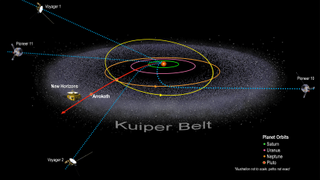
The cameras may have been turned off decades ago, but the spacecrafts' other instruments are collecting data on the plasma and magnetic fields from the sun at a great distance away from the star itself. Because particles of the solar wind — the constant stream of charged particles flowing off the sun — take time to travel such a long way, distant observations allow scientists to see how changes from the sun propagate throughout our cosmic neighborhood.
The edges of the solar system have been full of surprises, too. It would make sense that plasma from the sun becomes more sparse and spread out as you move away from the center of the solar system, but in fact, the Voyagers have encountered much denser plasma after crossing the heliopause. Astronomers are still puzzled about that one.
"It's just so amazing that even after all this time we continue to see the sun's influence in interstellar space," Spilker said. "I'm looking forward to Voyager continuing to operate, perhaps reaching the 50th anniversary."
Pioneers 10 and 11
The Pioneer spacecraft hold a special place in space history because of their role as, you guessed it, pioneers. Unfortunately, these milestone 50-year-old spacecraft are non-functional — Pioneer 10 lost communications back in 2003, and Pioneer 11 has been silent since its last contact in 1995.
But both these spacecraft are marks of humanity's presence in the solar system, and they are still continuing on their journeys, even if we're not sending them commands or firing their rockets anymore. Once a spacecraft is set on a trajectory out of the solar system, according to the laws of physics, it won't stop unless something changes its course.
New Horizons
New Horizons is by far the youngest sibling of these groundbreaking missions, having just launched in 2006 . After completing its famous flyby of dwarf planet Pluto in 2015 , this probe has been zooming out of the solar system at record speed, set to reach the heliopause around 2040.
Not only has it completed its primary mission, but it successfully completed a flyby of the smaller Kuiper Belt object, Arrokoth , in 2019 as its first mission extension. Earlier this year, the spacecraft was put into hibernation mode because an extended mission hadn't yet been approved. But now, the team is excitedly moving into New Horizons' 2nd Kuiper Belt Extended Mission, or KEM2 for short. KEM2 began on Oct. 1 , although the spacecraft will hibernate until March 1, 2023.
In the meantime, the mission team is preparing for exciting new observations. With cutting-edge instruments — far more advanced than what the Voyagers carried in the 1970s — the team is prepared to use New Horizons as a powerhouse observatory in the distant solar system, providing a viewpoint we can't achieve here on Earth .
Bonnie Burrati, planetary scientist at JPL and member of the New Horizons team, is particularly looking forward to new views of Kuiper Belt objects (KBOs), the chunks of ice and rock beyond Neptune . New Horizons' unique position in the outer solar system provides new angles of looking at these KBOs, she said. Different views can tell astronomers about how rough the objects' surfaces are, among other things, based on how light scatters and creates shadows on them.
Another planetary scientist on the team from Southwest Research Institute in Colorado, Leslie Young, wants to use the spacecraft for a new look at something closer to home: the ice giants, Uranus and Neptune. New Horizons’ unique viewpoint provides scientists with information about how light scatters through the planets’ atmospheres—information we can’t get from here on Earth, since we can’t see Uranus and Neptune from that angle. Planetary scientists are eager for more information about these planets, especially as NASA begins planning for a new mission to visit Uranus.
— The icy 'space snowman' Arrokoth in deep space just got names for its best features — Pale Blue Dot at 30: Voyager 1's iconic photo of Earth from space reveals our place in the universe — Destination Pluto: NASA's New Horizons mission in pictures
When the spacecraft wakes from hibernation, it will be past the so-called "Kuiper cliff," where scientists currently think there are far fewer large KBOs. "When we look at other star systems, we see debris disks extending to much larger distances from their host stars," Bryan Holler, an astronomer at Baltimore's Space Telescope Science Institute, told Space.com. "If ET were to look at our solar system, would they see the same thing?"
This next extended mission will even venture beyond New Horizons' original domain of planetary science. Now, the spacecraft will provide better-than-ever measurements of the background of light and cosmic rays in space, trace the distributions of dust throughout our solar system, and obtain crucial information on the sun's influence, complimentary to the Voyagers. Since the three functional far out spacecraft are heading in separate directions, they allow astronomers to map out irregularities in the solar system's structure.
Luckily for New Horizons, signs indicate that the spacecraft will have enough power to last through the 2040s and possibly beyond — each year, moving 300 million miles (480 million kilometers) farther into uncharted territory.
Follow the author at @ briles_34 on Twitter. Follow us on Twitter @ Spacedotcom and on Facebook .
Join our Space Forums to keep talking space on the latest missions, night sky and more! And if you have a news tip, correction or comment, let us know at: [email protected].

Briley Lewis (she/her) is a freelance science writer and Ph.D. Candidate/NSF Fellow at the University of California, Los Angeles studying Astronomy & Astrophysics. Follow her on Twitter @briles_34 or visit her website www.briley-lewis.com .
Satellites watch as 4th global coral bleaching event unfolds (image)
Happy Earth Day 2024! NASA picks 6 new airborne missions to study our changing planet
Watch 2 gorgeous supernova remnants evolve over 20 years (timelapse video)
- bolide I wonder if the JWST could see any of these satellites, if it aimed in their direction. Reply
bolide said: I wonder if the JWST could see any of these satellites, if it aimed in their direction.
- View All 2 Comments
Most Popular
- 2 Boeing Starliner 1st astronaut flight: Live updates
- 3 US Space Force picks Rocket Lab for 2025 Victus Haze space domain awareness mission
- 4 Exploding stars send out powerful bursts of energy − I'm leading a citizen scientist project to classify and learn about these bright flashes
- 5 Wow! Private space-junk probe snaps historic photo of discarded rocket in orbit
NASA Voyager Status Update on Voyager 1 Location

The consensus of the Voyager science team is that Voyager 1 has not yet reached interstellar space.
News Media Contact
Jia-Rui Cook
Jet Propulsion Laboratory, Pasadena, Calif.
818-354-0724

Welcome Back, Voyager
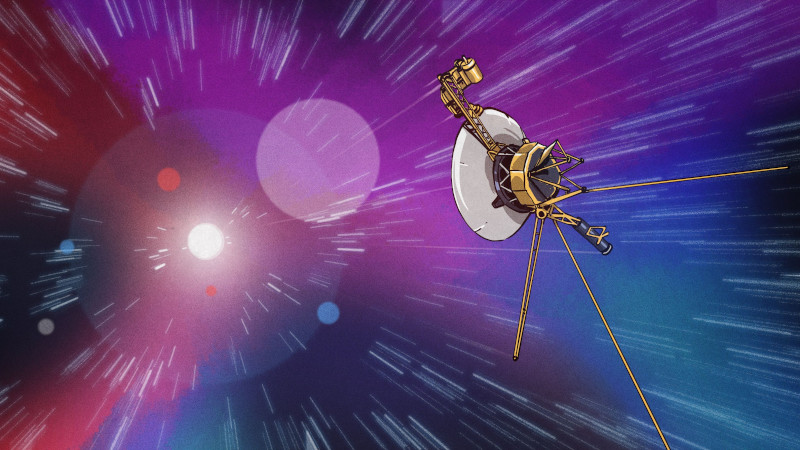
In what is probably the longest-distance tech support operation in history, the Voyager mission team succeeded in hacking their way around some defective memory and convincing their space probe to send sensor data back to earth again . And for the record, Voyager is a 46-year old system at a distance of now 24 billion kilometers, 22.5 light-hours, from the earth.
While the time delay that distance implies must have made for quite a tense couple days of waiting between sending the patch and finding out if it worked, the age of the computers onboard probably actually helped, in a strange way. Because the code is old-school machine language, one absolutely has to know all the memory addresses where each subroutine starts and ends. You don’t call a function like do_something(); but rather by loading an address in memory and jumping to it.
This means that the ground crew, in principle, knows where every instruction lives. If they also knew where all of the busted memory cells were, it would be a “simple” programming exercise to jump around the bad bits, and re-write all of the subroutine calls accordingly if larger chunks had to be moved. By “simple”, I of course mean “incredibly high stakes, and you’d better make sure you’ve got it right the first time.”
In a way, it’s a fantastic testament to simpler systems that they were able to patch their code around the memory holes. Think about trying to do this with a modern operating system that uses address space layout randomization , for instance. Of course, the purpose there is to make hacking directly on the memory harder, and that’s the opposite of what you’d want in a space probe.
Nonetheless, it’s a testament to careful work and clever software hacking that they managed to get Voyager back online. May she send for another 46 years!

40 thoughts on “ Welcome Back, Voyager ”
Amazing hack job by the support team! And what a testament to the engineers who designed Voyager! As a ham radio operator who builds my own gear from scratch, I am astonished that the meager signals transmitted by Voyager can be received here on Earth 24 billion kilometers distant! That is the ultimate record of miles-per-watt. How amazing that Voyager can still generate enough power to stay alive, let alone transmit and receive across 24,000,000,000 kilometers, traveling beyond the solar system.
As an amateur stove operator who cooks my own breakfast from basic ingredients, I am also astonished. Great work NASA. Go Science!
It is a classic Finite State Machine situation, given a machine with a known initial State, and not knowing its current state, how can the operator of the machine return it to a state where it’s outputs are intelligible by strategically choosing input states
Well, no. If the program is corrupted then you don’t know what states are even possible.
Activate the reset input.
As I understand it, this thing has a bootloader, and it is hard wired (Literally, by threading a wire though specific cores). The memory that got corrupted was of another type that was susceptible to wear, similar to Flash is now.
No, the CCS/AACS both run on plated wire memory, which is still reprogrammable. Plated wire is just core memory except instead of literal magnetic cores you plate the magnets on the wire, meaning that you can thread things automatically. They don’t need power to retain data, though.
You’re thinking of core rope, which is hard wired, like what Apollo used.
The memory that got corrupted was in the FDS, and it was CMOS RAM: so not flash, but just like normal SRAM (doesn’t need refreshing, does need power).
“Think about trying to do this with a modern operating system…” BADRAM option on GRUB, memmap on the linux kernel options… on windows, you’re probably screwed
Not really.
https://github.com/prsyahmi/BadMemory
If you’re using *nix, your head is likely screwed, too. Linux hits you harder, even. It’s sect like. Windows is honest about being bad, at least.
You could write a RTOS for a modern hardware and it will behave pretty much like a C64 hahahaha. It will be just way faster and with way more memory.
I dont know it the hardware itself it would be that reliable tho.
In a system that’s complex enough to have ASLR, it wouldn’t be an issue; the OS would just be told which physical page has the issue and would not map that into the MMU. The application code wouldn’t care.
>trying to do this with a modern operating system Actually its pretty easy… since the kernel knows the exact physical addresses it can simply not allocate anything into that region. Linux has the badram option for example.
>address space layout randomization Please actually read the article you link. It has nothing to do with how (where) things are laid out in the PHYSICAL memory.
“In a way, it’s a fantastic testament to simpler systems that they were able to patch their code around the memory holes. Think about trying to do this with a modern operating system that uses address space layout randomization, for instance. Of course, the purpose there is to make hacking directly on the memory harder, and that’s the opposite of what you’d want in a space probe. ”
There’s another, lesser known technique: using processor registers as a storage. It’s possible to write code in such a way that it can work without any RAM. The most popular example that comes to mind is a diagnostic software meant for the IBM PC 5150. It comes as ROM set and is being installed in place of the PC BIOS.
Also like the dead test cartridge for the C64. Operates only out of the ROM to test the RAM first to make sure it can use the stack before calling subroutines. If it fails, it uses screen flashes to indicate which RAM chip is bad. Pretty smart.
> You don’t call a function like do_something(); but rather by loading an address in memory and jumping to it.
Normally you use an assembler. Which counts instructions for you, and assigns that address a symbolic name like “do_something”.
I don’t think they wrote that thing in raw hex 1802 machine code. You could, but you wouldn’t.
> This means that the ground crew, in principle, knows where every instruction lives.
You know that for any compiled code, too, if you have a decent tool chain. Even with ASLR, you should be able to extract the addresses if you’re authorized. But I don’t think anybody’s going to ASLR embedded code in a space probe, precisely because they might need to do something like this.
I have patched compiled code live in running systems in the field. It’s unforgiving, but it’s not magic.
The real win is that the code is, by necessity, *simple*, and there’s not that much of it.
It wasn’t actually high stakes in the sense that a mistake wouldn’t have really done anything bad. Voyager isolated commanding in one computer, attitude/alignment in another, and flight data in a third.
The issue was with flight data, because it used CMOS. Screwing it up would’ve just meant programming it (via the other computers) again.
HI ! sorry, there’s never been Cosmac1802 on board of both Voyagers !!
True. The Galileo used six of them:
The CPUs of Spacecraft
https://www.cpushack.com/space-craft-cpu.html
The Voyager flight software would have been written around 1975 and had to fit in a few kilowords of RAM. I can guarantee you that no assembler was used, nor did any such thing as a “tool chain” even exist. The programmers almost certainly worked with quadrille pads (or if they were really fancy custom printed worksheets) organized to account for every word, and possibly even every bit, of that RAM. Since it was a real-time system running at kilohertz rates they probably also accounted for instruction processing cycles in some of the more critical routines. The full listing for such a system, ready for markup if necessary, would fit comfortably on a clipboard.
My understanding is that one of the modern Voyager team’s handicaps is that they did not have these detailed handwritten listings. However, after the “poke” experiment part of the response they got was a memory dump, which is probably one of the factors that allowed them to recreate them in enough detail to perform the real fix.
This kind of programming remained common through the early 1980’s because there were lots of embedded systems with just a few kilowords of memory and no runtime human user interface.
The big handicap they have is that they don’t have a working simulator for the FDS, since it, well, broke. The other issue is that I’m pretty sure both the FDS and CCS/AACS are custom processors so yeah, you’re totally right that there’s almost certainly no toolchain since the extant userbase is a total count of 1.
best OTA update ever. but not signed.
Danger of becoming a bitcoin miner.
so very much lol; thanks for that
A lot of what drove the design constraints of the day is weight. Old stuff was heavy, so there was a limit as to how much you could put on the satellite. If you took an equivalent weight budget and used modern technology you could have several multiples worth of spare everything available should a problem occur, and as others have pointed out have automatic remapping around failures.
It’s almost a 50 year old spacecraft. They had redundancies – they’ve just burned through them already. Both the spacecraft have a *ton* of failed components.
But the good part of this is, that we now have long-timedata about certain parts are lasting.
The next “Voyager” probe could then made with that same technology again, while other parts that didn’t last could be replaced by something else, something more enduring (modern, high-capacity core memory).
Assuming that we (humans) are still able to reproduce 1970s technology 1:1 using the old fabrication processes. Maybe NASA/JPL needs help by other states who still have the “know how” to produce 1970s technology.
(The USA aren’t exactly good at preserving “things”, I’m afraid. Everything old gets trashed, not saved. Storage costs. People rather love to produce cheap and sub-standard, to save money and exploit everyone as much as possible. Quality is too costly, after all. Except for military use. But that’s another story.)
What’s also being needed, of course, is a power source that will last for centuries. Considering the travel time and mission length, that might be a priority.
The RTGs on the Voyagers did last longer than expected, but not as long as the isotope itself possibly could still last. The RTG material itself was sort of a limiting factor, too.
Of course that won’t be happening, though, because “of progress”. People don’t like to set a specific standard into stone, for centuries (data format, transceiver technology).
But that’s exactly what’s being needed for a multi century mission.: The radio stations on earth must keep supporting same type of communication.
Similarly to how Latin was common language for centuries. Or how morse code can still be understood in emergency.
Alas, they won’t do that, I’m afraid. Instead, people will be improving specs on paper over and over again (“it needs to run on Linux!”), the years will be passing by, nothing happens.
In the end, a hundred years have passed by and there still won’t be a successor mission to the Voyagers. Then some catastrophe happens and the space programs will end altogether.
Or, we will see a couple of half-thought-through probes being sent out into deep space who will fail halfway on their mission or the money suddenly is getting short and actibe probes will be abandoned.
That’s just my point of view, of course. I’d love to be proven wrong.
“The USA aren’t exactly good at preserving “things”, I’m afraid. Everything old gets trashed, not saved. Storage costs. People rather love to produce cheap and sub-standard, to save money and exploit everyone as much as possible. Quality is too costly, after all. ”
Germany isn’t that much better in that respect. I ought to know. I’m an American. I’ve lived in Germany now for over 30 years. I am in a position to compare the two countries. There’s crap products there and here.
I’d really appreciate it if you’d cease bashing the USA in every conversation you take part in.
The insanity of saying “USA isn’t exactly good at preserving things” in an article about a 50-year old spacecraft which is still being actively used for science is pretty insane.
Anyone who starts out by saying “why haven’t we been sending out more Voyagers” doesn’t fully understand how amazing those missions are.
In 1964, JPL realized that the planets were going to align in the 1970s *exactly right* to allow sequential gravity assists to hit all the outer planets. This is literally a once-in-a-lifetime setup – the periodicity of that alignment is 175 years. The paper on this was published in 1966.
The Voyager craft were launched in ’77. This means that the US realized the importance and rarity of this mission and funded and built in *11 years* 2 probes that would last almost *50 years* so far.
The Voyager probes aren’t just a testament to engineering. They’re a testament to *humanity itself*.
“The RTGs on the Voyagers did last longer than expected”
What the heck are you talking about? They’re lasting exactly as long as expected. It’s an RTG. It’s not like a battery, you don’t get “lucky” with charge/discharge wear or something. They knew the power curve 30 years ago. They chose to use a few tricks in the power system to buy themselves more time, but that has nothing to do with the RTG.
“In the end, a hundred years have passed by and there still won’t be a successor mission to the Voyagers.”
Golly gee, I wonder why that is! It might have something to do with the fact that the planetary alignment used by the Voyagers *only happens once every 175 years*.
That alignment is what allowed them to get out as far as they did, since that’s how they got the *speed* they did.
I think you may enjoy reading “We are Bob”
“is probably the longest-distance tech support operation in history”
leave out the ‘probably’ !
> May she send for another 46 years! Voyager’s last message to Earth will be sometime near 2035 (half-life of the power source reducing and distance, AKA “Free Space Path Loss”, being the limiting factors). Unless we launch a massive number of relays to chase after them but the first relay would need a truly massive antenna massive.
But it would be a cool idea for a future probe to the nearest star system, Alpha Centauri (Only 4.246 light years). Send a probe followed by a new relay every few years to keep in touch. Of course they would need to be bunched close enough to allow for multiple relays failing over the duration of the trip there and the duration of the messages being relayed back to earth.
For reference Voyager 1 (traveling at 17.1 kilometers per second; 10.6 miles per second) will only need another 18,050 years until it is 1 light year away from earth! And 19,390 years until Voyager 2 (15.4 kilometers per second; 9.6 miles per second) is 1 light year away from earth!
Voyager’s science team is very clearly aiming for 2027, the 50-year anniversary. I’d imagine they will probably begin staffing down after that because there’s just no science return at that point.
My favorite is not that they are the farthest computers, but they are the longest continuously operating computers. They’ve been up for 50 years without going down once. Sure they step back into a safer operating mode, but they’ve never powered down and stopped completely.
There’s a nice documentary on the remaining Voyager team “it’s quieter in the twilight” on Amazon prime.
And checkout “Good Night Oppy” as well when there, it is about Opportunity on a 90 sols (92.5 Earth days) mission that lasted for 5352 sols (8 Mars years), 5498 days (15 Earth years).
Yeah ..that’s a good one too.
Thanks. Didn’t know about that one and it’s freeview with Amazon Prime.
I am glad to see Voyager is still out there. I know deep in my heart Voyager is connecting and expanding knowledge of Earth’s existence and place in the Cosmos for the Better of all and not for the worse.

Leave a Reply Cancel reply
Please be kind and respectful to help make the comments section excellent. ( Comment Policy )
This site uses Akismet to reduce spam. Learn how your comment data is processed .
Never miss a hack
If you missed it.

Mining And Refining: Uranium And Plutonium

Programming Ada: First Steps On The Desktop

The Hunt For MH370 Goes On With Barnacles As A Lead

MXM: Powerful, Misused, Hackable

VCF East 2024 Was Bigger And Better Than Ever
Our columns.

Hackaday Links: April 28, 2024

Hackaday Podcast Episode 268: RF Burns, Wireless Charging Sucks, And Barnacles Grow On Flaperons

This Week In Security: Cisco, Mitel, And AI False Flags

Keebin’ With Kristina: The One With The Transmitting Typewriter
By using our website and services, you expressly agree to the placement of our performance, functionality and advertising cookies. Learn more

Voyager 2 Position Calculator
Compute the position of Voyager 2 for any date and time between 1 January 2013 and 30 December 2099 and visualize the results on an interactive sky map.
Voyager 2 is an unmanned space probe launched by NASA on August 20, 1977, just a few weeks before its sister craft Voyager 1. Its mission was to study the outer planets of our solar system, including Jupiter, Saturn, Uranus, and Neptune. It was the first and only spacecraft to visit all four planets, and its observations revolutionized our understanding of these distant worlds. After completing its primary mission, Voyager 2 continued on its journey into interstellar space, where it is still sending back data on the interstellar medium and the heliosphere. Voyager 2 is currently the second most distant human-made object from Earth, after its sister craft Voyager 1, and continues to be in communication with NASA's Deep Space Network.
Voyager 2 is currently in the constellation of Pavo , at a distance of 20,367,086,506 kilometers from Earth.

Today's rise, transit and set times of Voyager 2 from Greenwich, United Kingdom (all times relative to the local timezone Europe/London):
Today Voyager 2 is not visible from Greenwich, United Kingdom
- Voyager 2 is below the horizon from Greenwich, United Kingdom .
- Go to interactive sky chart
If you need to access this information frequently for your observations, you can create a simple customized Quick Access page , so that you can easily bookmark it in your browser favorites or add a shortcut to your mobile phones' home screen.
- Position and finder charts (see also Where is Voyager 2? )
- Distance from Earth (see also How far is Voyager 2 from Earth? )
- When does Voyager 2 rise and set?
- Interactive orbit visualization . 3d visualization showing the orbit of Voyager 2 with respect to the major Solar System objects.
- 15 days ephemerides . Table showing celestial coordinates and magnitude of Voyager 2 for the past and next 7 days.
- Interactive sky chart . An online planetarium application that shows where to locate Voyager 2 in the sky from your location.
- Live position tracker . A high precision sky chart that uses real deep sky imagery to help locate Voyager 2 with your telescope or on your astrophotographies.
Voyager 2 Position and Finder Charts

Higher precision deep sky finder chart, 60 arcmin wide, showing where Voyager 2 is right now. Click on the image to see a more detailed fullscreen tracker view .

Also check out Where is Voyager 2? , a page that provides all the information needed to find Voyager 2 in the sky and additional links to sky charts.
Voyager 2 Distance from Earth
The distance of Voyager 2 from Earth is currently 20,367,086,506 kilometers, equivalent to 136.145564 Astronomical Units . Light takes 18 hours, 52 minutes and 17.2878 seconds to travel from Voyager 2 and arrive to us.
The following chart shows the distance of Voyager 2 from Earth as a function of time. In the chart the distance data is measured in Astronomical Units and sampled with an interval of 1 day.
Closest Approach of Voyager 2 to Earth
NOTE: values for the closest approach are computed with a sampling interval of 1 day.
Visualization of Voyager 2 Orbit
This 3d orbit diagram is a feature of our 3D Solar System Simulator and shows the orbit of Voyager 2 with respect of the Sun and the orbits of the major planets . The position of Voyager 2 and the planets along their orbits in this diagram accurately represents the current configuration of the objects in the Solar System. This is an experimental feature and it requires a WebGL enabled browser. Please provide us feedback !
Voyager 2 15 Days Ephemeris
The following table lists the ephemerides of Voyager 2 computed for the past and next 7 days, with a 24 hours interval. Click on each row of the table to locate Voyager 2 in our Online Planetarium at the chosen date.
Voyager 2 Ephemeris Calculator
Compute the position of Voyager 2 for any date and time between 1 January 2013 and 30 December 2099 and display the results on an interactive star map.

Interstellar Messengers
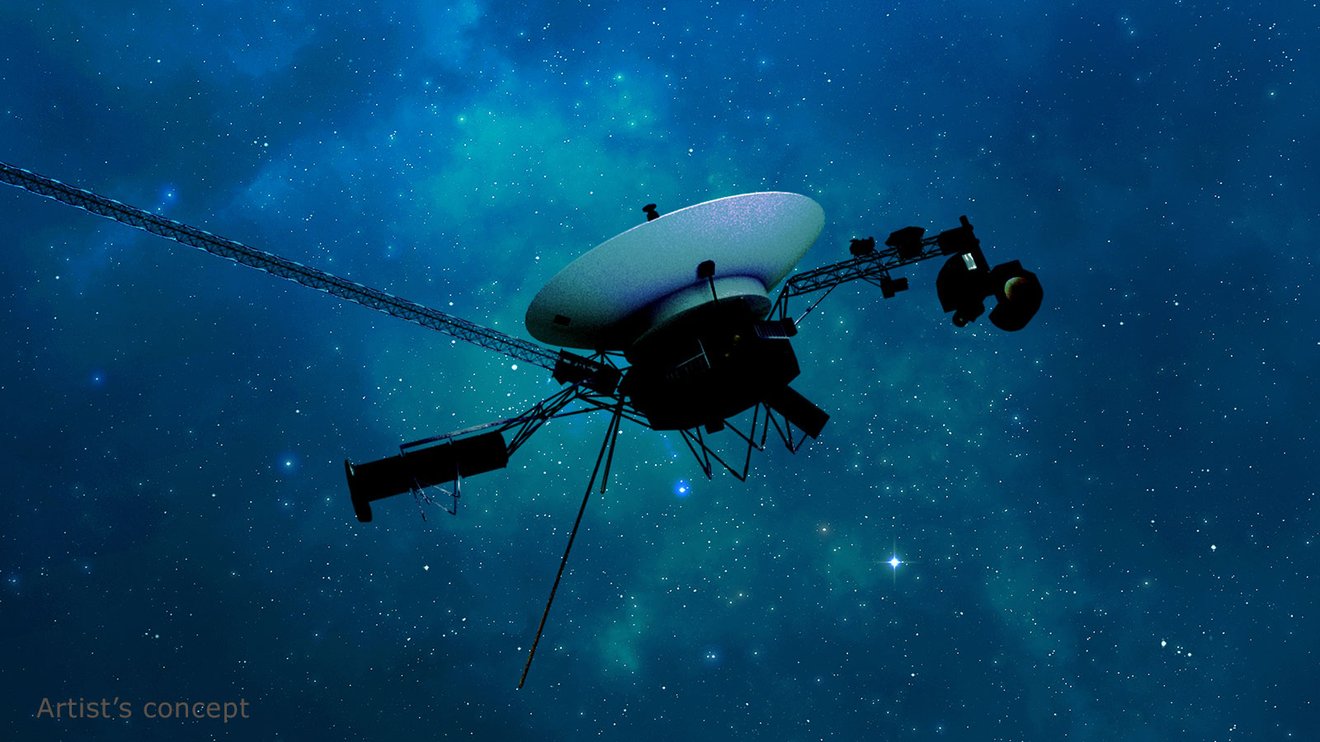
Voyager 1 and its twin Voyager 2 are the only spacecraft ever to operate outside the heliosphere, the protective bubble of particles and magnetic fields generated by the Sun. Voyager 1 reached the interstellar boundary in 2012, while Voyager 2 (traveling slower and in a different direction than its twin) reached it in 2018.
Mission Type
Science Targets
Voyager 1 & 2
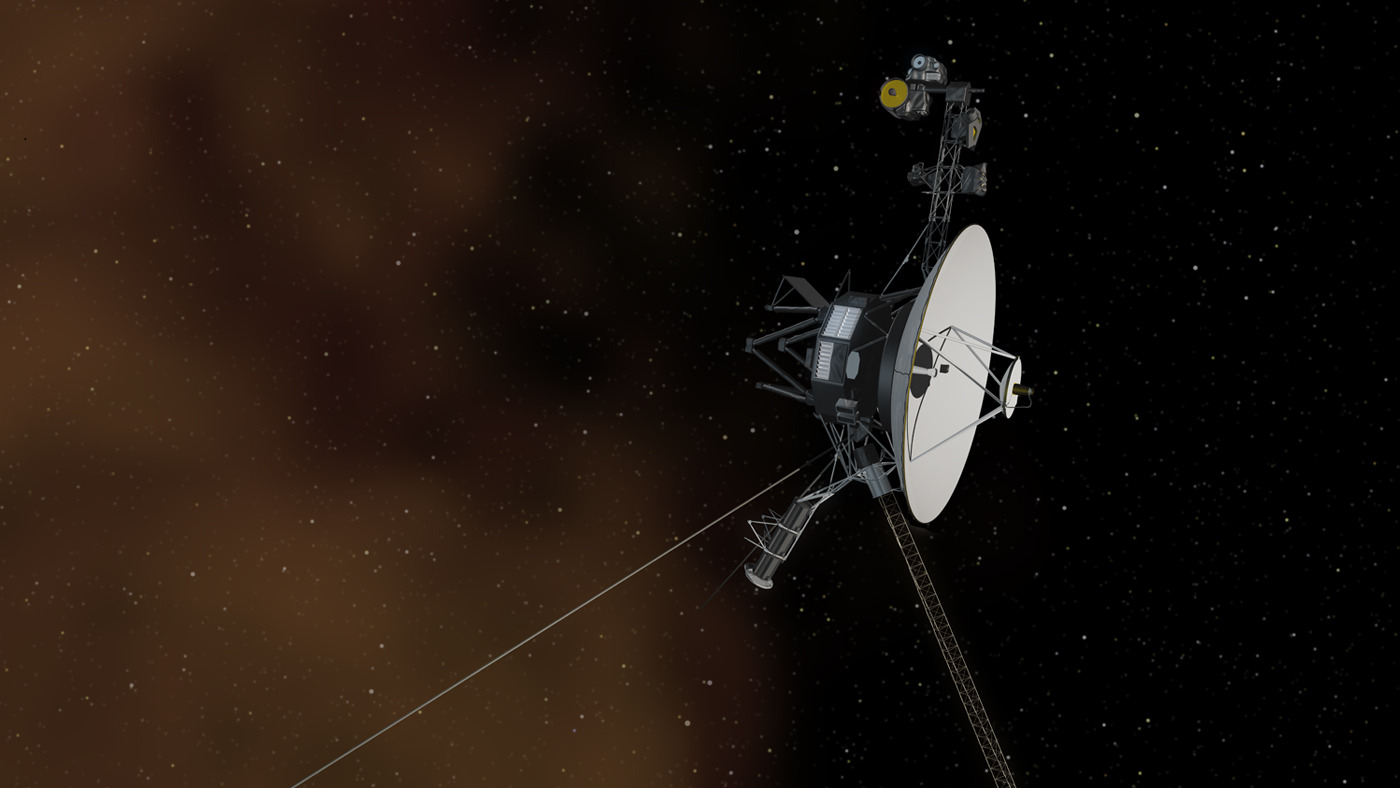
Mission Updates
Voyager 1 resumes sending engineering updates to Earth.
Latest News
NASA’s Voyager Team Focuses on Software Patch, Thrusters
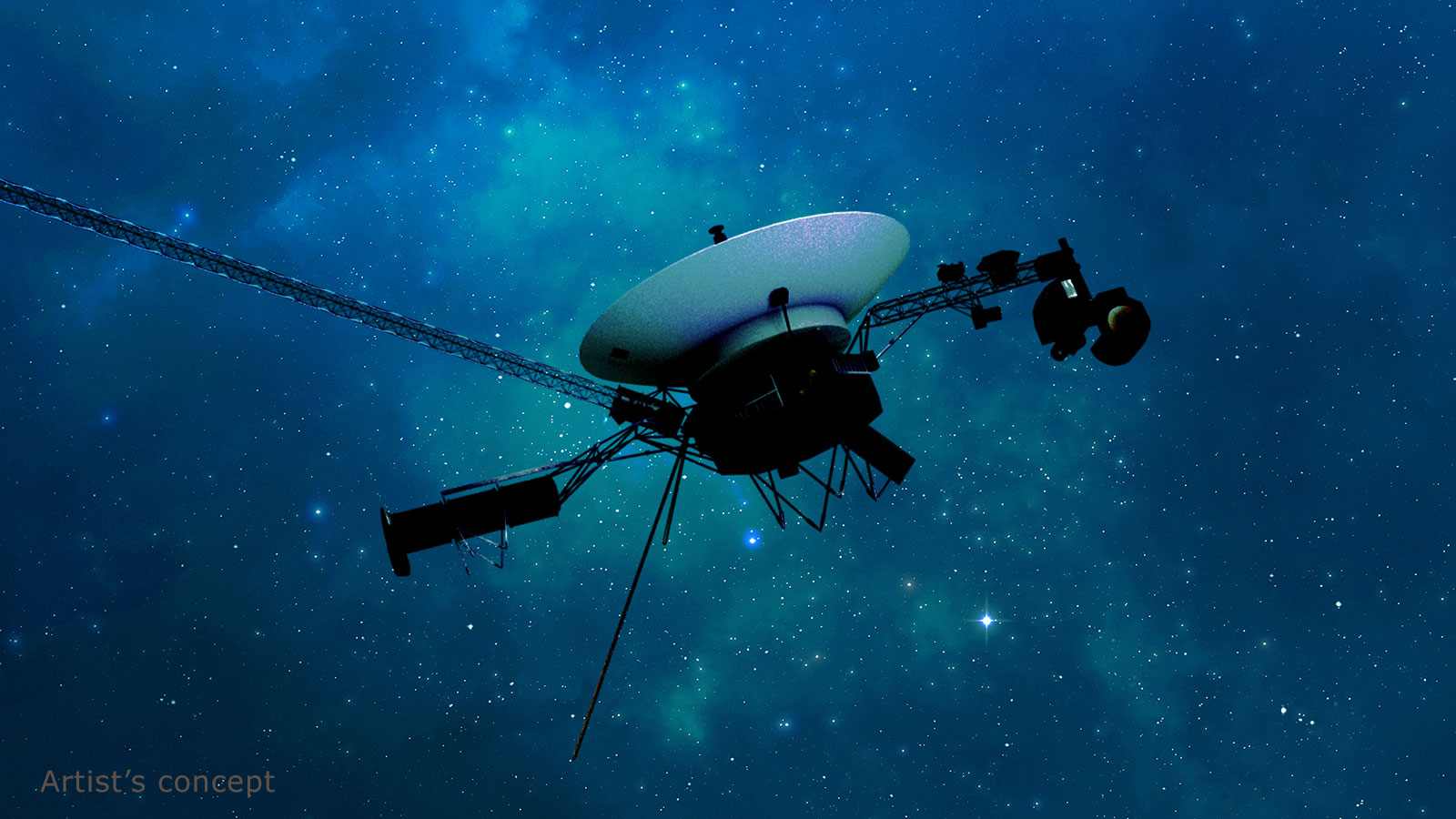
NASA’s Voyager Will Do More Science With New Power Strategy
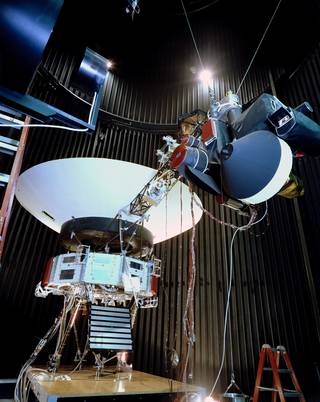
Edward Stone Retires After 50 Years as NASA Voyager’s Project Scientist
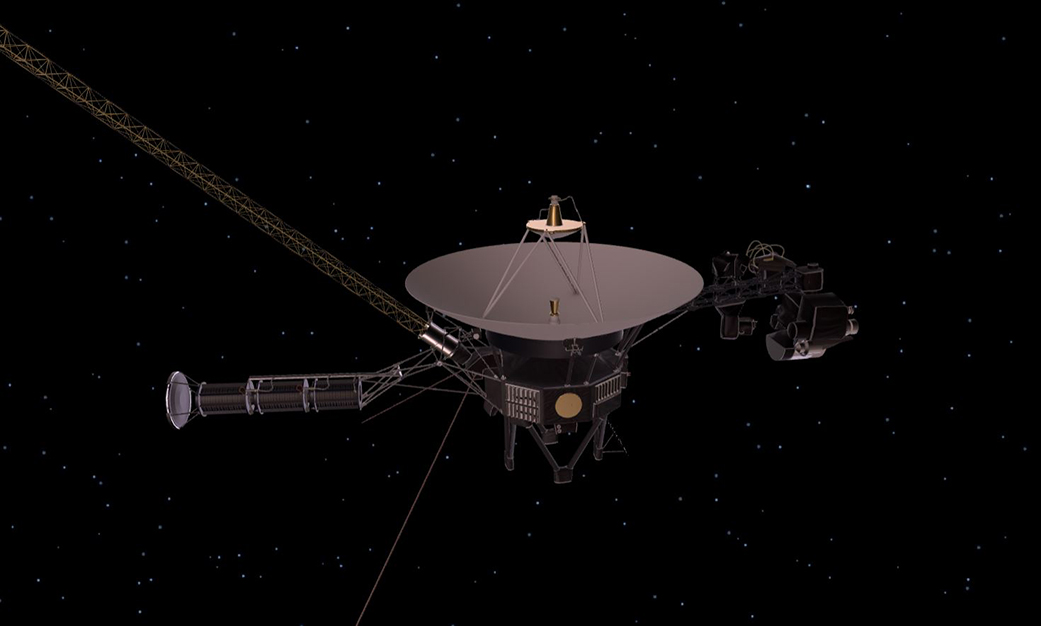
Engineers Solve Data Glitch on NASA’s Voyager 1
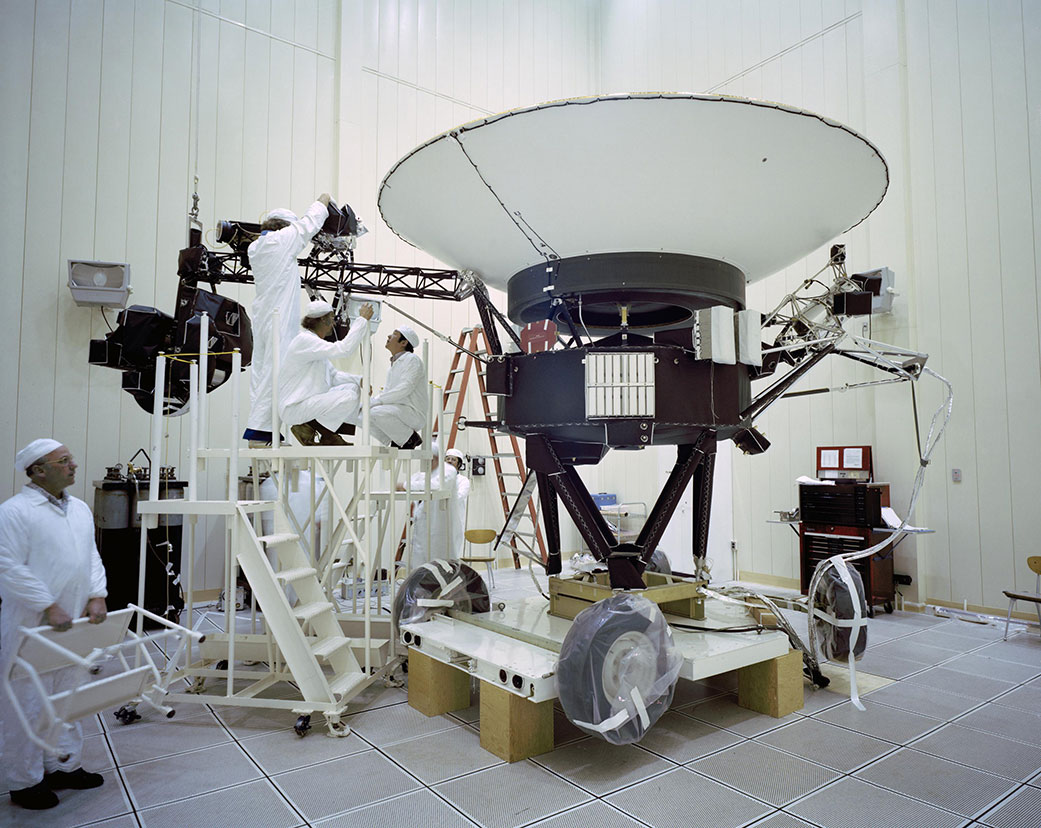
Voyager, NASA’s Longest-Lived Mission, Logs 45 Years in Space
The Interstellar Mission
After completing the first in-depth reconnaissance of the outer planets, the twin Voyagers are on a new mission to chart the edge of interstellar space.
The Golden Record
The contents of the golden record were selected for NASA by a committee led by Carl Sagan of Cornell University.
The Spacecraft
The twin Voyagers are escaping our solar system in different directions at more than 3 astronomical units (AU) a year.
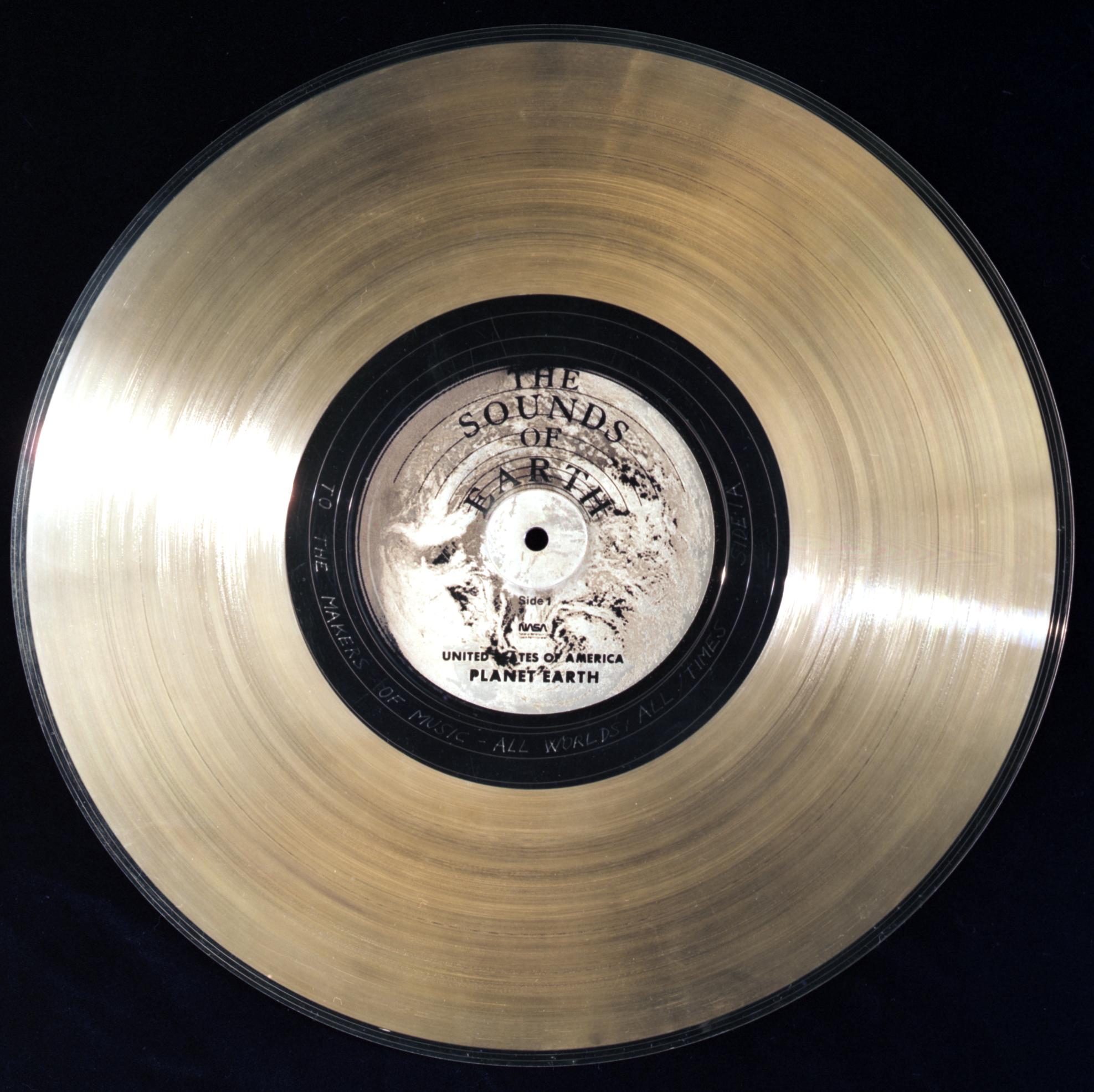
The Pale Blue Dot
The behind-the-scenes story of the making of Voyager 1's iconic image of Earth as "a mote of dust suspended in a sunbeam."

Discover More Topics From NASA

Our Solar System

Heliosphere
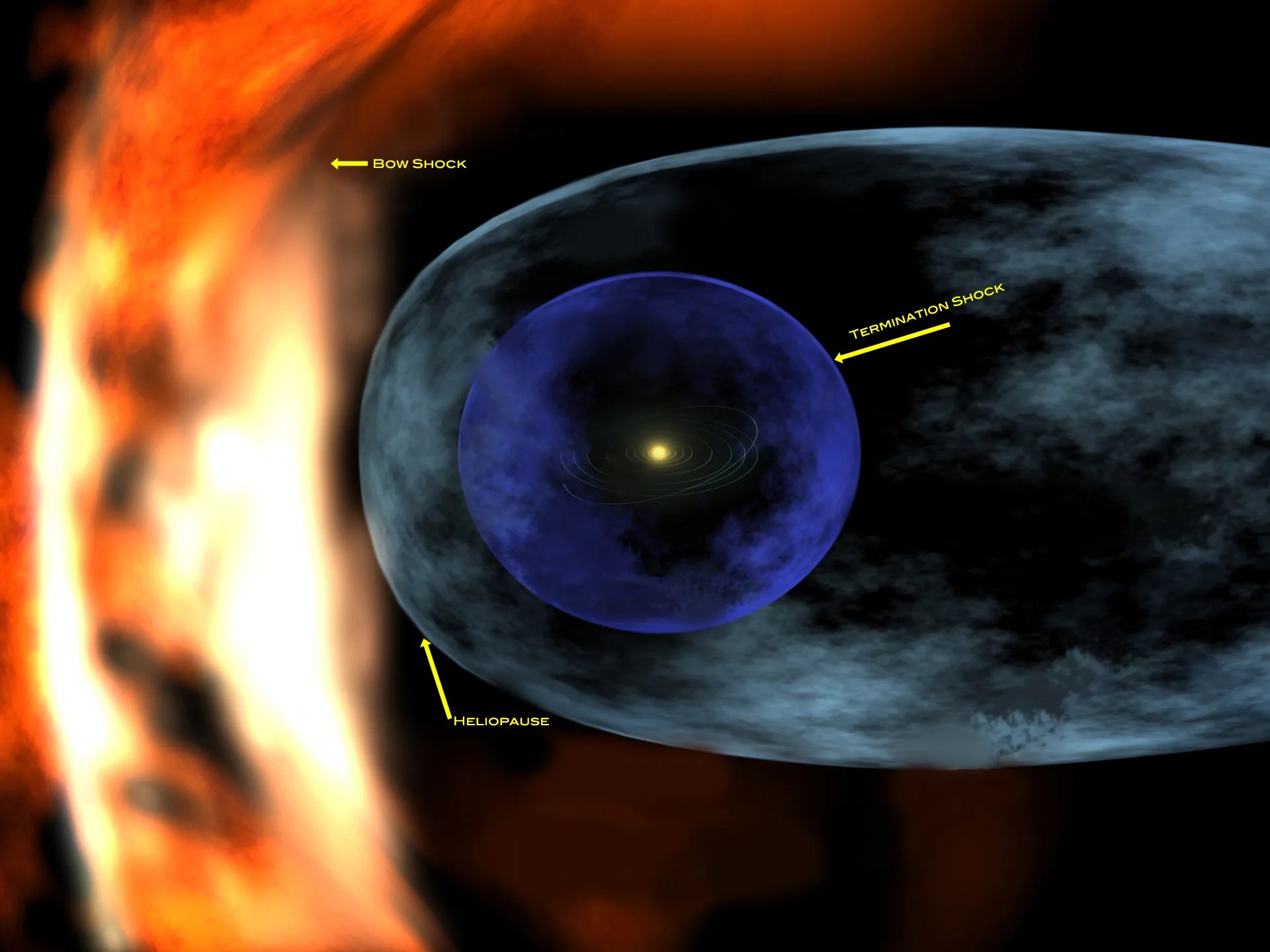
- CruiseMapper
- Marella Cruises
Marella Voyager
Former names: mein schiff herz (tui), mein schiff 2 (tui), celebrity mercury, mv mercury.
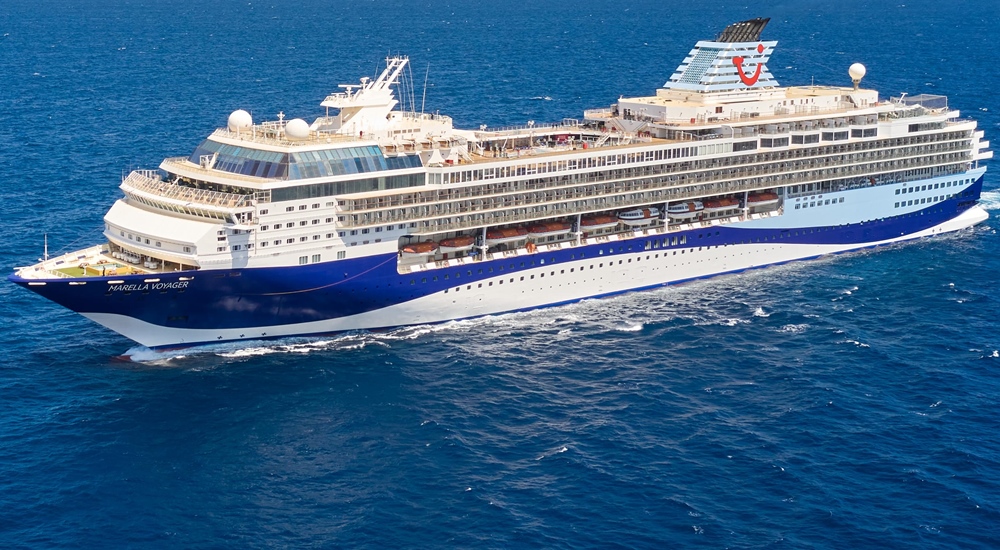
Cruise line Marella Cruises
- Palma de Mallorca (Majorca Island Balearic Spain)
- Bridgetown (Barbados)
Marella Voyager current position
Marella Voyager current location is at North East Atlantic Ocean (coordinates 35.90940 N / -6.00566 W) cruising at speed of 15.7 kn (29 km/h | 18 mph) en route to Malaga. The AIS position was reported 1 minute ago.
Current itinerary of Marella Voyager
Marella Voyager current cruise is 17 days, one-way from Bridgetown to Palma de Mallorca . Prices start from USD 1916 (double occupancy rates). The itinerary starts on 14 Apr, 2024 and ends on 01 May, 2024 .
Specifications of Marella Voyager
- Itineraries
- Review
- Wiki
Marella Voyager Itineraries
Marella voyager review, review of marella voyager.
The 1997-built Marella Voyager cruise ship (fka Mein Schiff Herz, and the old "Mein Schiff 2") was originally ordered and launched for Celebrity Cruises under the name Celebrity Mercury. The liner joined TUI Cruises (as "Mein Schiff 2") in 2009 and in 2019 was renamed "Mein Schiff Herz", after the newbuild Mein Schiff 2 took the old name upon entering TUI's fleet.
The vessel (IMO number 9106302) is currently Malta- flagged (MMSI 249053000) and registered in Valletta .
In mid-October 2021, TUI announced that in 2023 Schiff Herz will be transferred to Marella Cruises UK . The last voyage for TUI was scheduled for April 6, 2023.
Following a major drydock in 2023 (April-May), the ship (renamed Marella Voyager) started operations for Marella UK on June 3, 2023 (maiden Voyage).
History - construction and ownership
Marella Cruises (formerly Thomson Cruises UK) is a British passenger shipping company and trademarked travel brand owned by TUI Group. The company entered the cruise market in 1973 via Thomson Holidays (now TUI UK), but due to rising fuel costs, this service was terminated in 1976. Thomson Cruises restarted passenger shipping operations in 1995. The Thomson brand was renamed to "Marella Cruises" in 2018. Marella's parent company (TUI Group) owns hotels, the sister companies TUI Cruises, Marella Cruises, Hapag-Lloyd Cruises, the travel brands International Expeditions and Zegrahm Expeditions, also aircraft and the airlines Corsair International (France), TUI Airways (UK), TUI fly Nordic (Sweden), TUI fly Belgium, TUI fly Deutschland, TUI fly the Netherlands.
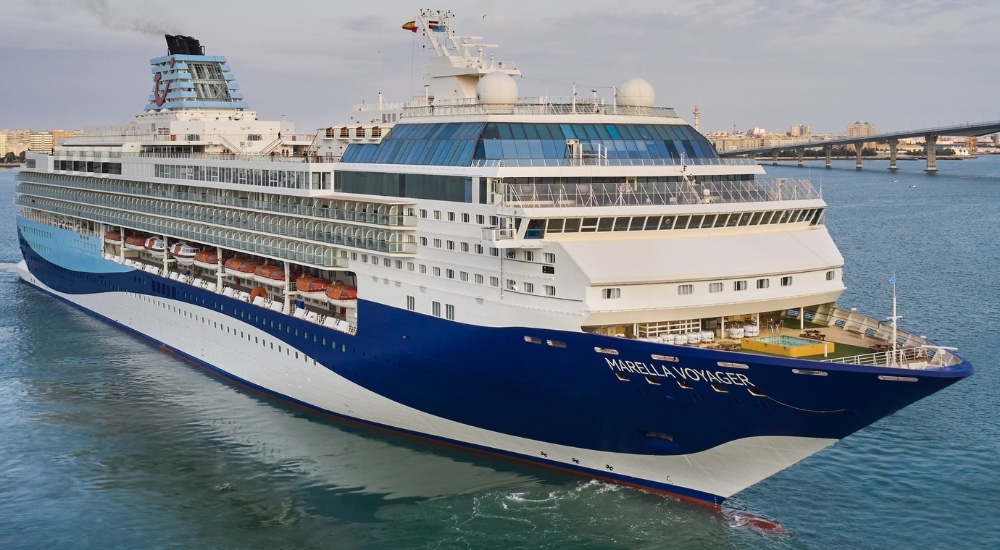
The vessel was delivered on November 2, 1997, as Celebrity Mercury. It was decommissioned in February 2011 and transferred to TUI in March 2011. In March-May 2011, the ship was in drydock (at Lloyd Werft Bremerhaven) and officially christened (Mein Schiff 2) on May 14, 2011. The 2011 rebuilding project cost the shipowner around EUR 50 million
The 1900-passenger ship Celebrity Mercury debuted in 1997 as the last of all three Century-class boats. The sisterships (Celebrity Galaxy and Celebrity Century) are currently named Marella Explorer (formerly Mein Schiff 1) and Marella Explorer 2 (formerly SkySea Golden Era).
Mein Schiff Herz entered service for TUI with passenger capacity 1912 (double occupancy/lower berths) and 956 staterooms (652 outside, of which 427 with balconies). Marella Voyager's capacity is 1904 passengers (952 staterooms).
After starting operations for TUI, Schiff 2 was homeported in Germany ( Hamburg and Kiel ) in 2011-2012. In the period Fall 2012 through November 2013, the boat was deployed in the Mediterranean. During winter were operated Caribbean cruises. For winter 2014-2015 season, the liner was deployed to Middle East (Arabian Sea) for roundtrips from Dubai .
In May 2015, RCCL decided to transfer the liner to Thomson Cruises (now Marella, within TUI Group) in 2019 under the name "TUI Explorer 2". Initially was announced that in March 2019, the old Schiff 2 (Herz) will be transferred to Marella as "Marella Explorer 2". In March 2018, TUI announced that it will stay in TUI fleet. The new name "Mein Schiff Herz" was announced in late-April.
Decks and Cabins
Marella Voyager staterooms (956/952 total) include 51x Suites and 376x Balcony cabins, with all 17 categories. The largest are the Ina Muller Themen Suites/Voyager Suites on Deck 10 - sized (530 ft2 / 49 m2 plus 140 ft2 / 13 m2 terrace).
All passenger staterooms offer as standard/complimentary amenities 2x single beds (1x Queen-size double bed convertible to twins), bedside cabinets (with drawers and reading lamps), sofabed (and/or 1-2 Pullman beds/fold-down beds), smart HDTV (satellite reception, infotainment system with on-demand movies, Internet, ship info channel), direct dial phone, wardrobe, electronic safe box and lifejackets (in the closet), minibar, Nespresso coffee machines (2x capsules are included per day), water carafe with glasses, mirrored dressing table (writing desk) with chair, en-suite bathroom (wall mounted toilet/WC, shower, single-sink vanity, hairdryer, bathrobes, slippers, bath products - shower gel, shampoo, conditioner), individually controlled air-conditioning, 24-hour room service.
The boat has 13 decks of which 10 are passenger-accessible and 6 with cabins.
(Marella Voyager ship review) Onboard facilities and amenities
In July 2022, Marella announced that the Voyager ship will have the fleet-firsts/new venues "Silver Fork" (a British-themed specialty restaurant), The Arts House (an art-themed bar where passengers can play shuffleboard and enjoy arts and crafts during the day, and live music performances in the evenings) and "The Kitchens" (a theatrical food hall that combines 8 separate eateries offering a wide variety of food - salads, sandwiches, roasts, desserts, ice cream).
DINING VENUES
The dining scene packs in a variety of restaurants (a total of 16 dining venues), such as waiter-service specialty spots, a self-service buffet, and grab-and-go snacks. Marella Voyager boasts some exclusive eateries like its Mexican Restaurant, the only one of its kind in the fleet. When it comes to bars, Marella Voyager's line-up ticks off everything from Squid & Anchor (the popular British-style pub) to the stylish Speakeasy Bar (new venue).
Abuela's (deck 11) is a new for Marella eatery open for lunch and dinner, which lines up a menu of classic Mexican foods, such as tacos and nachos, all made with authentic ingredients.
Platter (deck 7) is open late afternoons and evenings. The menu is designed for sharing and there is a wine list so guests can pair their tasty treats with a tipple or two. Reservations are recommended.
The Kitchens (deck 11) is made up of 8 different eateries. Guests can grab a salad or sandwich, stop by for ice cream or sit down for an Asian-style Curry or a roast dinner.
Snack Shack (deck 11) is the spot for bites to eat by the pool. It is nestled on the pool deck and offers grab 'n' go snacks and light options throughout the day.
Vista Room (deck 5) is in Latitude 53 (main dining room). In the evenings, it changes into a classy Italian restaurant with a menu of regional dishes all made with authentic ingredients.
Surf & Turf (deck 7) is a steakhouse/specialty restaurant offering premium seafood, chicken, lamb, steaks, various gourmet dishes, as well as a list of sides. There is a charge to dine here and reservations are recommended.
Latitude 53 (decks 5-6) is the main restaurant, spread across 2 floors. It is all waiter service here, and the floor-to-ceiling windows provide top-class views. Guests can expect a selection of classic British dishes.
Silver Fork (deck 5) is a specialty restaurant and another Marella Voyager exclusive. Its menu includes British favorites with a contemporary twist. There is a charge to dine here. Reservations are recommended.
Nonna's (deck 11) offers made-to-order pizza and pasta dishes for lunch and dinner along with many more Italian specialties for lunch and dinner.
Kora La (deck 7) is a firm Marella Cruises favorite. The eatery offers a selection of pan-Asian dishes. This is one of the ship's specialty restaurants, so there is a charge to dine here. Reservations are recommended.
ENTERTAINMENT VENUES
Marella Voyager's Broadway Show Lounge is big enough to rival the theatres in London's West End, and the shows are best-in-class. There are 11 productions throughout their voyage, with two showings every evening. Alternatively, guests are able to head to the Squid & Anchor Pub for a game show or a quiz. They can make their way to the Bar, Club and Casino, and let loose on the dancefloor or try their luck at the blackjack/roulette tables.
The Cinema (deck 6) screens a variety of Hollywood classic films along with the latest movie releases throughout the day and in the evenings.
Squid and Anchor (deck 7) is styled to look like a traditional British pub. In the evening, guests can enjoy everything from interactive game shows and quizzes to live bands and musicians.
The Sushi Bar is a specialty restaurant that serves sushi, sashimi, and nigiri that are prepared right in front of your eyes. It also serves cooked Japanese dishes, dim sum, desserts, and beverages. There is a charge to dine here, reservations are recommended.
Bar 53 (deck 5) is right by the main dining room, so it is the ideal place for pre-dinner drinks.
The Exchange (deck 8) has got a hidden-away feel. The menu offers unique cocktails that are not available elsewhere on the ship. In the evenings, guests can expect immersive entertainment and live music. There is a charge here and reservations are recommended.
Flutes (deck 5) is where guests can sip glasses of Champagne/Prosecco while listening to a pianist. It is split over 2 floors, and there are "push for bubbles" buttons around.
The Shack (deck 12) is a drinking hole that looks out over the pool deck and features a drinks menu of classic alcoholic options, frozen cocktails, and soft drinks.
Electric Rooms Bar/Lounge, Nightclub & Casino (deck 12) offers a drinks menu that has something for everyone, the club has an LED dancefloor, and the casino counts blackjack/roulette among the featured games tables.
The Arts House (deck 6) is an art-themed bar unique to Marella Voyager. Passengers can play shuffleboard or get stuck into some arts & crafts here in the daytime. Come evening, live musicians and singers take over.
Broadway Show Lounge (decks 6-7) offers shows that are well worth a shout-out, 11 in total, with 2 performances per night.
Aperitif (deck 7) is a drinking spot near a few of the specialty restaurants, making it a pick for pre-dinner drinks. The Aperitif Bar also has an extensive gin and whiskey menu.
OTHER ONBOARD AMENITIES (wellness/Spa & fitness, pools, shopping, sports, kids-teens)
The Coffee Port is a one-stop shop for hot drinks/sweet treats. Luxurious Lavazza is on the menu, alongside a selection of pastries, cakes, and other confectioneries. Drinks here are only included as part of the line's Premium Drinks Package.
The Deck Bar is next to the pool, making it the best watering hole for post-swim cocktails.
The Summerhouse (between Abuela's and Nonna's) is a bar specializing in cold beers and Mexican cocktails. It has an indoor space (covered by a retractable roof) and an open-air seating area.
The Crazy Golf (on the top deck) is where vacationers can work on their putting skills during a round on the mini-golf course.
The Medical Centre/Infirmary on deck 4 has resident English-speaking physicians and nurses on 24-hour duty, also providing prescriptions and consultations.
The Broad Street Shops sell duty-free merchandise and have everything from in-fashion perfumes to classy jewelry and plenty of souvenirs. Since July 2023, Marella Voyager's onboard retail shops are managed by Harding+ (UK-based travel and cruise retail group). On the ship were also introduced new brands like Fable (British-themed fashion accessories and jewelry), Pandora (jewelry), Rolex (Swiss watches), TAG Heuer (luxury chronograph Swiss watches), Thought Clothing UK (women's garments made from sustainable fibers/cotton, wool, hemp, bamboo).
- Note: In 2020, Harding was acquired by Davidson Kempner Capital Management LP (1983-founded, NYC-based investment management firm with USD 34+ billion in managed assets).
- Harding has hubs in Bristol (England) , Miami (Florida USA) and Sydney (NSW Australia) .
The Reception is open 24/7, so the friendly team is always on hand to help with any queries.
The Destination Services on deck 5 is where passengers can book a place on one of the line's shore excursions, or find out more about the ports they'll visit.
The Cruise Holiday Store on deck 6 is where vacationers can book another cruise while they are at sea.
The Photo Studio is where guests can schedule a professional photo shoot with one of the onboard photographers. There are many kiosks dotted around the vessel to view and buy any pictures taken during the sessions.
The Hideout (teen lounge) is a hangout spot for older children and teenagers. It is loaded with game consoles and comfy chairs. In the high season, it hosts supervised organized games and events.
M Club (kids lounge) features games and activities for the little ones hosted by the M Crew cast of characters exclusive to Marella. There are many evening activities, too like pizza-making sessions and movie nights.
Mini M Club is the ship's nursery where babies and toddlers can relax and play. It hosts various youngster-friendly activities, such as story time sessions and arts & crafts.
The Gym is where guests can work out with a sea-view backdrop. It has everything needed for a full-body workout, including cardio machines and strength-training gear.
The Pool is the site for a lot of the action on Marella Voyager. Passengers can get involved with the daily entertainment schedule here or enjoy a relaxing soak.
The Kids' pool is reserved for littler cruisers, and it is the perfect size to enjoy a cool-down splash.
Two whirlpools are available next to the outdoor pool. Each one is fitted with water jets.
Spa & Beauty Salon. The treatment menu includes all the usuals, from manicures and pedicures to facials and massages. Since November 2022, Marella UK (via partnership with OneSpaWorld Holdings/health and wellness company) provides ocean-inspired wellness products and services on all its ships.
- The range of OneSpaWorld's services includes Ocean Body Treatments (massages and polishes), Ocean Facial, Ocean Salon Services.
- On Marella ships, OneSpaWorld uses premium beauty brands like Elemis, L'Oreal, Kerastase.
- The brands owned by OneSpaWorld include Mandara Spa, Bliss Spa, Chavana Spa, Glow Spa.
The Veranda is at the front of the ship, providing a selection of Balinese beds. It is in a spot that offers first-class views, and the call-for-drinks buttons give it a luxe feel.
The Jogging Track is found on the top deck, meaning guests can count their steps and enjoy some fresh air while taking in the beautiful sea views.
(Mein Schiff Herz ship review) Onboard facilities and amenities
Follows the complete list of Mein Schiff Herz restaurants and food bars.
- Atlantic Classic (950-seat, complimentary main dining room (of all three) for buffet-style Breakfast and waiter-served Lunch and Dinner. Some menu inclusions are at extra charge.
- Richards (aka Fine Dining/65-seat dinner restaurant, reservations required, at surcharge PP)
- Dinnerzimmer (private dining annex to the Steakhouse restaurant)
- Surf und Turf (specialty seafood and steakhouse restaurant)
- Blaue Welt Bar (45-seat sushi bar at a surcharge, dinner-only between 6:30-11 pm.)
- Anckelmannsplatz buffet restaurant (412-seat, with partially covered outdoor area for al-fresco dining; complimentary, self-service, with various food stations)
- GOSCH Sylt (80-seat complimentary seafood restaurant, a la carte menu; with outdoor seating area)
- Cliff Grill 24 (24-hour, 40-seat complimentary Grill Bar, serving the pool deck area)
- La Vela (66-seat complimentary bistro)
- Aussenalster Bar (97-seat complimentary al fresco dining and sports bar with 153-seat outdoor seating area).
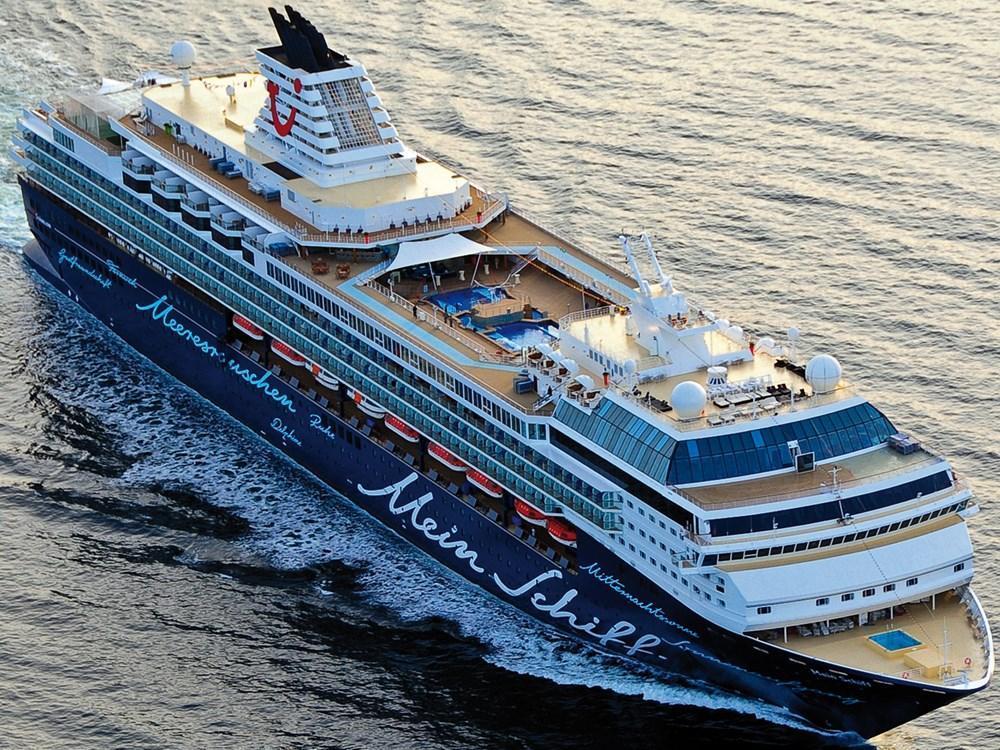
Almost all beverages, food and gratuities are included in cruise ticket prices. The aft-located Diamond Bar (at the rear) offers classy evening entertainment. The Show Lounge presents musicals, acrobatics, magic and stand-up comedy shows. Disco dancing in AbtanzBar in the evenings is among the most popular onboard activities.
The ship has Sea Spa (with beauty salon and saunas) and a large fitness area (also used for aerobic classes). The wellness area consists of a steam room and a large sea-view sauna room. Sport-themed excursions are offered during port days and include scuba diving, snorkeling, mountain biking, paddle boating.
Follows the complete list of Mein Schiff 2 lounges, clubs and other entertainment venues for kids, teens and adults.
- Theatre (main show lounge for grand-style show productions / 2 nightly shows; had a revolving stage and eight dynamic LED screens)
- Internet computers room
- Sturmfrei (Teens Lounge featuring video gaming consoles, dance floor, foosball table, activities like karaoke, cooking classes, teen parties, movies, etc.)
- Atelier (Workshop/art studio for painters); Art Gallery; Fotogalerie (Photo Gallery); Library/Bibliothek
- Meerleben (Sea Life - the first-at-sea marine life and maritime dedicated area)
- Wein und Wahrheit Vinothek (20-seat fine wine shop)
- Schau Bar (248-seat cocktail bar with outdoor seating area for 18 guests)
- The Neuer Wall shopping arcades
- Blaue Welt (Bar Lounge), TUI Bar; Unschlag Bar (60-seat sports bar); Uberschau Bar (50-seat wellness bar with a "healthy drinks" menu)
- Himmel und Meer Lounge (Suite Guests only); X-Lounge (Suite-guests only lounge)
- SPA und Meer (SPA and Sea complex with a Finnish Sauna, Oriental steam bath, relaxation area, Thalassotherapy centre, Thalasso Spa Suite, Samova Tea Lounge, Beauty Salon)
- Sport und Gesunheit (Sport and Health Fitness Centre; Fitness classes/personal trainers provided at surcharge)
- 2 swimming pools - Aussenpool (outdoor pool area with a 25 m long swimming pool), a smaller pool, 4 Whirlpools, extensive sunbathing area, served by Unverzicht Bar)
- Insel der Seerauber (Pirates' Island Kids Club complimentary lounge)
- Sun deck area (11,990 m2; the forward section features Entspannungsinseln/Relaxation Islands with mini-balconies, available for rent)
- Outdoor sports area (with a full-size Sports Court for playing basketball, volleyball, tennis, plus a golf simulator)
- Grune Oase (Green Oasis - outdoor sports area for open-air classes - stretching, relaxation, Yoga, Pilates); Power Walking / Jogging Track.
TUI schiff einkaufsbummel (onboard shopping)
TUI schiff SPA und Sport
TUI schiff sonnenbereiche und poolbereiche (sundeck and pool deck areas)
Itineraries
After joining Marella Cruises and following a month-long drydock refurbishment in Cadiz Spain , the boat (renamed Marella Voyager) started operations on June 3, 2023 (Maiden Voyage/7-day "Highlights Of The Mediterranean" itinerary), leaving from Palma de Mallorca.
Marella Voyager's cruises were open for booking on November 4, 2021.
The inaugural season's itineraries (all 7-day roundtrips from Palma de Mallorca/Majorca Island ) included:
- "Mediterranean Secrets" (June through September 2023) visits Piombino (Siena & Pisa), Savona (Genoa & Turin), Calvi (Corsica), Toulon (France), Palamos (Spain).
- "Highlights of the Mediterranean ((June-Oct 2023) visits Ajaccio (Corsica), Civitavecchia-Rome, Livorno (Florence & Pisa), St Raphael (St Tropez & Cannes), Barcelona.
- "Magic of Spain" (July-Oct 2023) visits Gibraltar, Cadiz-Seville, Malaga, Cartagena, Valencia.
- "Cosmopolitan Classics" (July-Oct 2023) visits Palamos, Villefranche (Monaco & Nice), Piombino (Siena & Pisa), Naples (Pompeii & Capri), Olbia (Sardinia).
For winter 2023-2024 (Nov-April) the ship was deployed in the Caribbean and homeported in Bridgetown Barbados. The 7-day itineraries were operated with UK fly-cruise packages. The ex-Barbados Caribbean program was based no 3x different itineraries - Paradise Islands (Tortola BV, Philipsburg St Maarten, Basseterre St Kitts, St Johns Antigua, Roseau Dominica), Tropical Delights (Castries St Lucia, St Georges Grenada, Kralendijk Bonaire, Oranjestad Aruba, Willemstad Curacao) and A Taste Of The Tropics (Scarborough Tobago, St Georges Grenada, Castries St Lucia, Kingstown/St Vincent Grenadines, Pointe-a-Pitre Guadeloupe).
Mein Schiff Herz itineraries
Mein Schiff Herz's itinerary program was based on Mediterranean roundtrips leaving from homeport Palma de Mallorca (Balearic Spain) during summer, and voyages to Spain's Canary Islands during winter (leaving out of homeport Tenerife ).
Mediterranean itineraries visited ports in France (including Corsica Island), Italy (including the islands Sardinia and Sicily), Spain (overnight in Barcelona), Malta (Valletta Harbour), UK (Gibraltar), Greece (also the Greek isles Crete and Santorini).
The roundtrips to the Canaries also visited Portugal's Madeira Island (Funchal). Roundtrip Tenerife itineraries visited Cape Verde Islands (western Africa) and Portugal's Azores Islands.
For winter 2020-2021 season (November through March), TUI planned for Mein Schiff Herz a deployment in South Africa. The 14-day roundtrip itinerary (from homeport Cape Town ) visited Port Elizabeth and Walvis Bay Namibia , both with overnight stays. The season had to start on December 2nd (2020) with pricing from EUR 3100 pp (inclusive of the roundtrip flight Germany-South Africa).
However, due to the Coronavirus crisis, these plans were canceled and Schiff Herz restarted operations on September 3, 2021 (7-day and 14-day Mediterranean itineraries from homeports Palma de Mallorca and Malaga ).
Marella Voyager - user reviews and comments
Photos of marella voyager.

Marella Voyager ship related cruise news
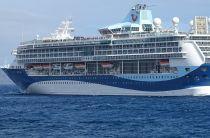
Marella UK unveils summer 2025 itineraries, incorporating 10 cruise-and-stay packages
Marella Cruises UK unveiled its summer 2025 itineraries, incorporating 10 cruise-and-stay packages into the offerings. Marella Discovery 2 ship is...

Trimline rebrands 5th Marella Cruises UK ship
Trimline marks a milestone as they successfully complete their fifth rebranding endeavor for Marella Cruises UK, focusing on the refurbishment of...

Harding+ (UK) signed retail management deals for 3 new cruise ships
Harding+ has recently introduced its retail offerings on 3 newly launched ships, marking an important achievement for the cruise retailer. The...

Marella UK’s 5th cruise ship Marella Voyager starts operations
The TUI AG-owned and TUI UK-managed Marella Cruises is launching its 5th ship - Marella Voyager, on Saturday, June 3rd as she begins Mediterranean...

Godmothers announced for Marella UK's newest cruise ship Marella Voyager
Marella Cruises has broken with tradition by choosing two of its own crew members as the godmothers for its newest ship Marella Voyager/fka Mein...

27-year-old Brazilian missing after disembarking from Mein Schiff Herz in Gibraltar
A Brazilian man has gone missing in Gibraltar UK on Saturday, November 5, after disembarking from the TUI's ship Mein Schiff Herz. The missing...

Marella Cruises UK expands SPA partnership with OneSpaWorld
Marella UK expanded its partnership with OneSpaWorld in order to enable it to provide ocean-inspired products/services onboard its 4 ships from...

Marella Cruises’ newest ship Marella Voyager (TUI's Schiff Herz) to feature exclusive new facilities
Marella UK's newest ship, Marella Voyager, will boast a range of new facilities and designs when she begins sailing in summer 2023. New venues...

Marella Cruises announces new 2023 winter program
Marella UK announced a new and expanded 2023 winter program for its 5-ship fleet. Marella's 5th ship - Marella Voyager/currently TUI's Schiff Herz...

TUI Cruises' ship Mein Schiff Herz denied port entry in Tangier (Morocco) due to COVID cases onboard
The Moroccan authorities prevented the TUI's ship Mein Schiff Herz from docking at Port Tangier (Morocco, Tanger-Ville), because of an increase in...
- show more news
Other Marella Cruises cruise ships
- Marella Discovery
- Marella Discovery 2
- Marella Explorer
- Marella Explorer 2
Marella Voyager Wiki
The ship's powerplant is based on MAN B&W marine diesel engines (models 6UEC52LS and 9L48/60) with combined power output 31,5 MW (42240 hp).
The vessel has Meyer Werft Papenburg yard/hull number 639, volume 77302 GT-tons, DWT-deadweight tonnage 9600 tons, max draught 8,5 m.
The 3rd Rockliner concert (with Udo Lindenberg) took place on Schiff 2 in 2014. The previous two rock-themed music cruises were on the sistership Schiff 1 (held in 2010). Schiff 2 also hosted the 5th "Full Metal Cruise" (in 2016). The previous four were on Schiff 1.
Schiff 2's godmother was Anja Fichtel - fence champion at Summer Olympics 1988 (Seoul, South Korea). TUI Herz ship's Captain was Helge Wrage.
On April 18, 2023, Chris Hackney (Marella's Managing Director) announced that Marella Voyager will have two godmothers, both of whom are employees of TUI/Marella - Tatyana "Tatty" Olkhovska (Chief Purser since 2017, with TUI since 2003) and Jacqui Nobile (Senior Manager of Destination Services Operations, with TUI since 1994). Curiously, the ship's godmothers were selected in consultation with TUI's senior management, and the criteria were the employee's length of service and career progression within the company.
The naming ceremony was initially scheduled for May 31, 2023, to be held in Port Malaga (Spain) .
Next two tables show the ship's last voyage for TUI (from Tenerife) and the first voyage for Marella UK (from Majorca), both in 2023.
(Mein Schiff Herz) 10-day relocation itinerary (RepositionCruises.com) from the Canaries to Majorca.
(Marella Voyager's MAIDEN VOYAGE 2023) 7-day "Highlights Of The Mediterranean" itinerary - from GBP 1195 (EUR 1430 / USD 1550) per person with double occupancy.
(inaugural Transatlantic crossing) 15 day from Europe to Caribbean/barbados
7-day Caribbean itinerary "Paradise Islands "
7-day Caribbean itinerary "Tropical Delights"
7-day Caribbean itinerary "A Taste Of The Tropics"
Marella Voyager refurbishment 2023 review
The ship's first (bu Marella UK) drydock refurbishment was in 2023 (April-May), conducted at the Navantia Shipyard in Cadiz Spain .
The drydocking in 2023 was a full-scale (33-day) refit and refurb project that included adding many of Marella's signature venues, facilities and amenities, as well as new for the British brand venues - Abuela's (Mexican restaurant) and the Speakeasy Bar.
The scope of works also included a full machinery/systems overhaul, as well as superstructure and hull cleaning and painting.
The project was supervised by Trimline Group (UK-based interior outfitting company), led by Naomi Cooper (Director of Projects for Trimline Ltd/on-site management team). It involved 180 workers/contractors including electricians, decorators, upholsterers, floor layers, joiners, laborers, hard surface repair experts, polishers, plumbers, welders, HVAC and other specialists.
Among the new spaces is The Exchange (Marella's first) featuring an art deco bar (with a classic speak-easy ambiance) and the Flutes (champagne bar). The renovations also included the installation of LED lighting by GDS Pioneering Light (Bristol England-based manufacturer).
Trimline UK-redesigned spaces included the venues Squid & Anchor, two restaurants (Latitude, Vista), the new Santorini and St Lucia-themed suites, Destination Experiences, Dining Club, M Club, as well as 900+ passenger staterooms.
All public areas received new carpeting. The Broadway Show Lounge was fully renovated. The Electric Rooms (Bar/Lounge and Nightclub & Casino) received a state-of-the-art LED dance floor.
TUI Mein Schiff Herz refurbishments review
Mein Schiff Herz's last drydock refurbishment (by TUI) was in March 2022 (by Navantia in Cadiz).
The ship's drydock 2019 refurbishment (February 14 - March 2, in Marseille France ) resulted in the following updates and changes: hull works (including repainting), machinery works (general maintenance), overhaul/redesign and renovations of interior spaces (X-Lounge, all Junior Suites, Shore Excursions Office, Anckelmannsplatz/Lido Buffet restaurant).
A new Italian specialty restaurant (La Spezia) was opened via a partnership with celebrity chef Theodor Falser.
Drydock 2013 refurbishment (November 1-7, in Cadiz) resulted in the following changes:
A new outdoor yoga area (Deck 12) was installed. The LED lighting and new carpeting in public places were installed. Cliff 24 Bar was renovated. The entire exterior was repainted, including the hull (with new / eco coating).

IMAGES
VIDEO
COMMENTS
Both Voyager 1 and Voyager 2 have reached "Interstellar space" and each continue their unique journey through the Universe. In the NASA Eyes on the Solar System app, you can see the real spacecraft trajectories of the Voyagers, which are updated every five minutes. Distance and velocities are updated in real-time.
Voyager 1 Present Position. This simulated view of the solar system allows you to explore the planets, moons, asteroids, comets, and spacecraft exploring our solar system. You can also fast-forward and rewind in real-time. NASA/JPL-Caltech.
The probe and its twin, Voyager 2, are the only spacecraft to ever fly in interstellar space (the space between stars). Voyager 1 stopped sending readable science and engineering data back to Earth on Nov. 14, 2023, even though mission controllers could tell the spacecraft was still receiving their commands and otherwise operating normally.
On Saturday, April 5, Voyager 1 finally "phoned home" and updated its NASA operating team about its health. The interstellar explorer is back in touch after five months of sending back nonsense data.
The spacecraft launched in 1977 and is now 15 billion miles from Earth. It went silent in November. ... Voyager 1 is now some 15 billion miles away from Earth. ... takes final position as star of ...
The Voyager 1 and Voyager 2 probes launched in 1977 on a mission to study Jupiter and Saturn but continued onward through the outer reaches of the solar system. In 2012, Voyager 1 became the first ...
This is a real-time indicator of Voyager 1's distance from Earth in astronomical units (AU) and either miles (mi) or kilometers (km). Note: Because Earth moves around the sun faster than Voyager 1 is speeding away from the inner solar system, the distance between Earth and the spacecraft actually decreases at certain times of year.
Launched in 1977, Voyager 1 was mankind's first spacecraft to enter the interstellar medium, in 2012, and is currently more than 24 billion kilometres from Earth.. Messages sent from Earth take ...
Voyager 1 and 2, cruising along diverging paths, made history by crossing the heliopause in 2012 and 2018, respectively (SN: 9/12/13; SN: 12/10/18). At nearly 18 billion kilometers from the sun ...
Voyager 1 and 2 were launched 16 days apart in 1977. At least one of the spacecraft has visited Jupiter, Saturn, Uranus and Neptune. Voyager 1 is the most distant human-made object, about 11 billion miles (18 billion kilometers) away from the sun. The signal from Voyager 1 takes approximately 17 hours to travel to Earth.
GREENFIELDBOYCE: Spilker says the plan now is to find some more free memory on a working chip and put in the software that will let Voyager 1 resume transmission of its science data, so that ...
Compute the position of Voyager 1 for any date and time between 1 January 2013 and 30 December 2099 and display the results on an interactive star map ... showing where Voyager 1 is right now. Click on the image to see a more detailed fullscreen tracker view. Voyager 1 RA: 17h 16m 00s Dec: +12° 21' 10" Deep sky finder chart for Voyager 1 ...
Mission Overview. The twin Voyager 1 and 2 spacecraft are exploring where nothing from Earth has flown before. Continuing on their more-than-40-year journey since their 1977 launches, they each are much farther away from Earth and the sun than Pluto. In August 2012, Voyager 1 made the historic entry into interstellar space, the region between ...
NASA and Voyager 1 are communicating back and forth again, after the most distant human-made object in space stopped sending usable data back to the space agency nearly five months ago. NASA's ...
It takes 22 1/2 hours to send a signal to Voyager 1, more than 15 billion miles (24 billion kilometers) away in interstellar space. The signal travel time is double that for a round trip.
Voyager 2 is now more than 96 AU from the sun, traveling at a speed of 15.5 kilometers per second (9.6 miles per second). Both spacecraft are moving considerably faster than Pioneers 10 and 11, two earlier spacecraft that became the first robotic visitors to fly past Jupiter and Saturn in the mid-70s. This processed color image of Jupiter was ...
Voyager 1 has been exploring our solar system for more than 45 years. The probe is now in interstellar space, the region outside the heliopause, or the bubble of energetic particles and magnetic fields from the Sun. Voyager 1 is the first human-made object to venture into interstellar space. Voyager 1 discovered a thin ring around Jupiter and ...
A computer glitch scrambled Voyager 1's communications with Earth, leaving NASA in the dark. Now, scientists have restored Voyager 1 and are making sense of its signals from interstellar space.
We now have five spacecraft that have either reached the edges of our solar system or are fast approaching it: Pioneer 10, Pioneer 11, Voyager 1, Voyager 2 and New Horizons. Most of these probes ...
Voyager 1 live position and data. This page shows Voyager 1 location and other relevant astronomical data in real time. The celestial coordinates, magnitude, distances and speed are updated in real time and are computed using high quality data sets provided by the JPL Horizons ephemeris service (see acknowledgements for details). The sky map shown in the background represents a rectangular ...
About the mission. Voyager 1 reached interstellar space in August 2012 and is the most distant human-made object in existence. Launched just shortly after its twin spacecraft, Voyager 2, in 1977, Voyager 1 explored the Jovian and Saturnian systems discovering new moons, active volcanoes and a wealth of data about the outer solar system.
The consensus of the Voyager science team is that Voyager 1 has not yet reached interstellar space. "The Voyager team is aware of reports today that NASA's Voyager 1 has left the solar system," said Edward Stone, Voyager project scientist based at the California Institute of Technology, Pasadena, Calif. "It is the consensus of the Voyager ...
We're still inside, apparently. But the magnetic field now is connected to the outside. So it's like a highway letting particles in and out." ... Position of Voyager 1 (Live-Counter) Voyager 1 (NSSDC Master Catalog) Heavens-above.com: Spacecraft Escaping the Solar System - current positions and diagrams;
This week, an analysis of ancient DNA sheds light on a bygone empire, Voyager 1 is back in touch with NASA, what to do now that the cicadas are here, and more.
I've lived in Germany now for over 30 years. I am in a position to compare the two countries. There's crap products there and here. ... Voyager's last message to Earth will be sometime near ...
Compute the position of Voyager 2 for any date and time between 1 January 2013 and 30 December 2099 and display the results on an interactive star map ... showing where Voyager 2 is right now. Click on the image to see a more detailed fullscreen tracker view. Voyager 2 RA: 20h 13m 36s Dec: -59° 03' 55" Deep sky finder chart for Voyager 2 ...
Spacecraft. The identical Voyager spacecraft are three-axis stabilized systems that use celestial or gyro referenced attitude control to maintain pointing of the high-gain antennas toward Earth. The prime mission science payload consisted of 10 instruments (11 investigations including radio science).
Where are They Now? What Voyager 1 and its twin Voyager 2 are the only spacecraft ever to operate outside the heliosphere, the protective bubble of particles and magnetic fields generated by the Sun. Voyager 1 reached the interstellar boundary in 2012, while Voyager 2 (traveling slower and in a different direction than its twin) reached it in 2018.
NASA Voyager Status Update on Voyager 1 Location. Artist concept of NASA's Voyager spacecraft. Image credit: NASA/JPL-Caltech › larger image. "The Voyager team is aware of reports today that NASA's Voyager 1 has left the solar system," said Edward Stone, Voyager project scientist based at the California Institute of Technology, Pasadena, Calif.
Marella Voyager cruise ship itinerary, 2024-2025-2026 itineraries (homeports, dates, prices), cruise tracker (ship location now/current position tracking), review, news